How to Create a Market Research Proposal (+Template)
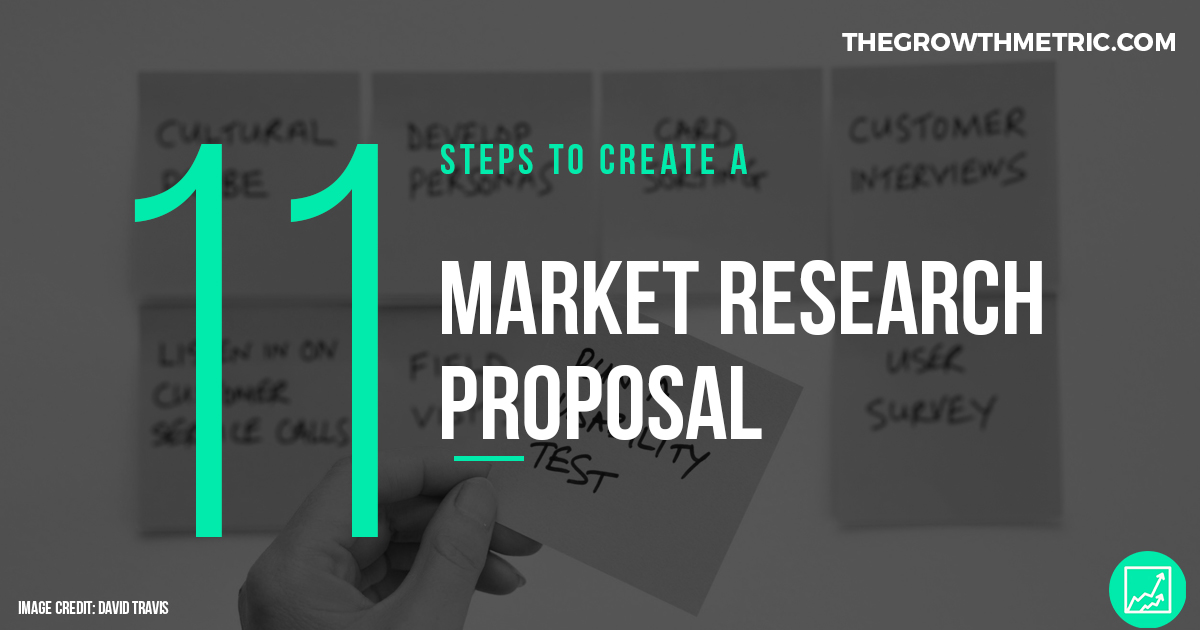
Continuing the market research series, in this article, we’ll discuss what a market research proposal is and how to create one.
To recap, what we’ve covered so far in the series, we’ve talked about what market research is, the different types of market research you need to do to grow your business, and the benefits of conducting market research .

What is A Market Research Proposal
Conducting market research is expensive, and if you work in a large organization, then you would need to justify such expenses.
Before conducting your research you’d need to shed some light on past data about your market, gaps in the data, and why new research is necessary.
This is where a Market Research Proposal come in to play.
Typically, a research proposal is a document proposing a research project, usually, these proposals are done by a scientist or an academic.
The proposals are then evaluated on the cost and potential impact of the proposed research, and on the soundness of the proposed plan for carrying it out. Research proposals generally address several key points:
- What research question(s) will be addressed, and how they will be addressed
- How much time and expense will be required for the research
- What prior research has been done on the topic
- How the results of the research will be evaluated
- How the research will benefit the sponsoring organization and other parties involved
The same principles apply here, only that your business market environment is what is being researched, which is your target market.
A market research proposal is a document that details the what, the where, the when and the how of market research and the information and costs associated with it.
If this sounds complicated, then here’s what you need to know about a market proposal. It addresses:
- Why market research is necessary and what you aim to gain from the research
- What resources are required for the research
- Past research done on your market
- How the data from this market research will be collected, stored and used
- How the research will benefit your business
Keep in mind that at this point you are not conducting the research yet, you are simply providing a rationale behind why market research is necessary.
In the next article in this “Market Research” series, we will discuss the process of conducting market research, but for now, we need to provide a compelling document on why, how, when and where the research will be conducted.
11 Steps to Create A Market Research Proposal

Now that you know what a market research proposal is, it’s time to create one. There are 11 steps to create a sound and compelling market research proposal
1. Market Research Proposal Summary
Start your proposal by briefly explaining the purpose of the market research and why it is required. Also, give an overview of what the desired outcome of the market research is.
If your business is interested in pouring resources into an in-depth market research then surely, there is something you hope to gain from it.
Remember to provide reasoning for the need of this specific market research and let whoever is reading this, such as the CEO, COO. know what contributions this research will make to the company.
TEMPLATE TO USE:
The market research project, entitled [RESEARCH PROJECT TITLE] hopes to discover more information regarding market trends in [SPECIFIC AREA]. The following summary will give an overview of the causes, processes, and possible effects of the market research proposal, detailed below.
2. Research Objectives
In this section of your proposal give full details about what problem has been identified that requires market research to be conducted. I.e. Show why there is a specific need for this research in the first place.
Explain what the market research results will be used for and how they will help achieve the overall goals. Describe the goals which you hope to achieve with this project.
The proposed market research project contains the following objectives:
- Objective one
- Objective two
3. Background Information on Past Market Research
Odds are you’re not the first person/company to conduct research on your market. This means that there is existing information on your market. However, this knowledge might be outdated, or might not provide the data your business needs.
So, in this section explain what information already exists on this topic and what is already known. Also, highlight the gaps in knowledge that the market research will hopefully fill.
Here you will show information from existing sources regarding the specific topic to be researched. It is great to provide cited sources, graphs, charts, and statistics.
You will use this section to show that you know a great deal about the market you will be researching, but you also need to show the holes in the current knowledge.
You can then demonstrate the specific need for your proposed research plan, and how this market research plan will fill these holes and contribute to the knowledge of this subject.
4. Market Research Proposal Hypothesis
If your business needs to conduct market research, then you probably have a few ideas of what you hope to get or learn from the research.
In this section describe what you believed to be the likely outcome of the market research and what you hope to learn.
5. Research Target Audience
Your business doesn’t target everyone, and odds are your business targets different audience types. So who is this research targeted at?
This is a very important part of your proposal and you need to be as detailed as possible about the target audience or audiences you will be researching.
Also, describe how you will source this target audience and how you will ensure they meet the correct criteria.
6. Data Collection of Market Research
Time to get to the good stuff. In this part of your proposal, you MUST detail all the data collection methods that will be used during the market research and, how they will be carried out.
You MUST also explain how the accuracy of data will be maintained, how potential candidates for the research will be approached and, if applicable, how they will be reimbursed for their time and contribution.
Use specifics and consider potential questions such as.
- How will you maintain the accuracy of data?
- How will you approach potential survey or research candidates?
- Will these participants be paid for their time?
- At what times of day will you make phone calls?
- In what ways will you ensure an accurate data sample?
The more information you can provide in this section, the better.
Our methods of data collection will be best suited to the project at hand. Research methods will include:
- Focus groups
- Collection of social media data
- Surveys via the Internet, phone, or email
- Long range in-home consumer tests
- Distribution of samples
- In person promotionals
These individuals will be selected [HOW THEY ARE SELECTED] to ensure an appropriately constituted pool of data from which we can infer accurate insights and trends.
The pool itself comprises of individuals who have expressed to us an interest in participating in such surveys, and they will be compensated by [METHOD OF COMPENSATION]….
7. Research and Analysis Methodology
In this section of your proposal, you are to discuss the strengths and possible limitations of your research methods.
Provide an overall blueprint for your methodology in approaching research data, and describe the implications of each method of data collection, and explain the methods you will use to interpret the data.
Lastly, discuss the means of evaluating the collected data and how you will account for errors, holes in data, or inaccuracies.
8. Ethics to be Followed During Research
You’re almost done with your proposal, but there are still a few important details that need to be included.
Explain how the market research will adhere to ethical codes by thinking about how issues such as participant confidentiality, data security, privacy, and consent of research participants will be addressed.
Include waivers or documents you plan to provide to research participants, if applicable
9. Market Research Timeline
In this section, provide a detailed timeline of when the research needs to begin and when a full report is required, ensure sufficient and realistic time for both data collection and data analysis are considered.
Market Research Timeline
- Task 1 ([DATE] [TIME])
- Task 2 ([DATE] [TIME])
- Task 3 ([DATE] [TIME])
10. Market Research Budget
We’re almost done with our proposal, but it’s time to include arguably the most important section. After all, if your company does not have the funds and resources then there would be no research in the first place.
Provide an overall budget for the proposed project. Make sure to include all possible cost considerations. You can provide a breakdown of those here.
Don’t forget budgets for sections such as Participant Reimbursement, funds for documents, rental space.
11. Conclusion
This is the last part of your market research proposal. You can add ways in which this market research will provide further benefits or include unique applications of the potential results.
Now that you know the market research proposal process and the importance of market research, in the next article will discuss the actual market research process.
Comment with any questions you have about Market Research Proposals and I will get back to you ASAP.

Receive Growth Marketing Resources Directly To Your Email
Join The Growth Metric's mailing list to receive the latest resources and blog posts.
Almost there, click on the confirmation email!
Post navigation, leave a reply cancel reply.
Your email address will not be published. Required fields are marked *
This site uses Akismet to reduce spam. Learn how your comment data is processed .

- Tour Solutions Resources Pricing
- Contact Sales
- START FREE TRIAL
- All Industries >

How To Write Market Research Proposal: Tips and Best Practices

Entrepreneurs and companies need to get critical information about their industry or specific market landscape to help ensure their business becomes a success.
This is where market research plays a role. But to be effective, proper steps must be outlined through a market research proposal.
If you’re a business owner or a marketer, you must learn how to write a market research proposal correctly . So here’s a handy step-by-step guide on how to do just that. Plus, we’ll throw in a free template to help you get started.
Table of Contents
How To Write a Market Research Proposal
When drafting a market research proposal , you can adopt various styles depending on the industry or business. But to put forth a more organized proposal, it helps to adhere to proven structures and follow these steps.
1. Start with an overview
It’s always wise to open with an overview to give the readers of the proposal a general idea of what the market research is all about, as well as set their expectations. If you don’t want to use the term overview, you can also go with an executive summary or an introduction.
You can do a simple overview consisting of one to three paragraphs. Or if the situation calls for it, you can also present your executive summary with supporting information that may include any or all of the following:
- Definition of terms. List the terms that will be used in the market research proposal. Make sure to define them properly.
- Market conditions. Give an overall picture of the current market conditions. Explain the industry’s state and the competition level, as well as mention relevant economic or even political factors.
- Strengths, weaknesses, opportunities, and threats (SWOT) analysis. You can also present market conditions through a SWOT diagram, which summarizes everything neatly.
- Feasibility. If you want to cut to the chase, state the overall feasibility. You can also consider including the potential ROI (return on investment ).
2. Define the objectives
When writing a market research proposal, define the project’s goals as clearly as possible. You can begin with a larger, encompassing objective and then break it up with its corresponding parts.
If you are dealing with multiple goals, make sure to explain how each separate objective relates to or affects one another.
Remember that clearly defined goals will guide the execution of the market research project – from the budget to the types of surveys or questions you will use.
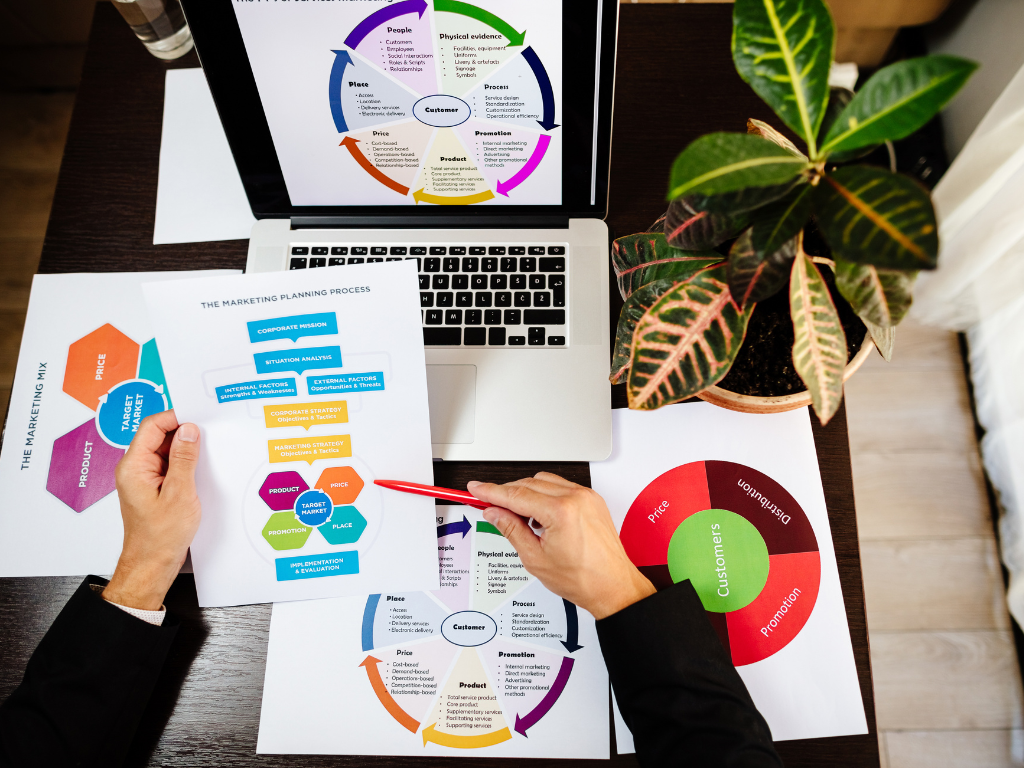
3. Outline the execution
Market research can be accomplished in various ways, but there needs to be a clear plan for executing it.
Outline your methodology and approach to getting the information you need. As far as methods are concerned, you can choose from options like organizing focus groups, deploying online surveys, or holding interviews over the phone or face-to-face.
You should also consider if your approach is multi-faceted. Will the surveys be done once or through a series of batches? Will you follow up on the first wave of interviews with email surveys?
Never forget to include the rationale for choosing your methodology. Factors to remember include costs, logistics, and timeline.
4. Explain how the results will be analyzed and reported
Market research proposal creation would be incomplete without including the mechanics for analyzing and reporting the results.
You must present a concrete plan for how the market research data will be collected and safely stored.
Next on your list is to explain how the data will be analyzed. Of course, what comes after is the reporting part. It’s more than just presenting the facts. You should also include your interpretations and, more importantly, your recommendations.
5. Discuss the timeline, costs, and conditions
Market research takes time and isn’t free. So, you’ll need to define your timeline and expected costs clearly.
It’s also important to tackle the terms and conditions of the market research project. The more transparent you are, the more you can prevent misunderstandings in the future.
Download the Market Research Proposal Template
When drafting a market research proposal, you can accomplish things faster using a reliable template.
Sign up now for a free account at Fill to get a market research proposal template. It’s just one of several templates that we offer for free.

Market Research Proposal
Common Mistakes to Avoid When Writing a Market Research Proposal
It’s not enough to know how to draft a market research proposal. You also have to be aware of common mistakes people commit when preparing these proposals.
- Lack of details. When you already know how to create market research proposals, you use certain structures and templates repeatedly. But sometimes, you forget to add elements that make your proposal look legit instead of being an apparent copy of another.
- There is not enough review and fact-checking. We’re not talking about simple spelling and grammar errors. We’re referring to the information you included in your market research proposal. Are they up-to-date? Are the sources considered trustworthy?
- There is too much hype. Be careful not to get caught up in the excitement of your proposal. Remember that you are dealing with business people. Be realistic and be clear about the goals. The last thing you need is to promise something you can’t deliver.
- Disorganized presentation. You can follow a decent structure when writing your market research proposal. But if you don’t organize the information you present in each section, you will you’re lose your reader’s interest.
- Underestimating visuals and diagrams. Yes, it’s showing real data is important, but you can be more persuasive by strategically using visuals, graphs, charts, and tables in your proposal.
Using Fill to Create Your Market Research Proposal
Now that you know how to write a market research proposal, it’s time to put your learnings into practice immediately.
Create an account at Fill and grab a free market research proposal template today.
Andria is a seasoned content writer, specializing in document management solutions and HIPAA compliance, providing valuable insights for businesses and professionals alike.
Manage contracts, forms and eSignatures effortlessly.
Related Stories

How to Create an Online Signature
How to Create Form 8594 With Fill’s Customizable Template
Learn how to create form 8594 using Fill's customizable template feature. Make tax form completion effortless with Fill—a robust and secure eSignature app.
Agreement vs Contract: What’s the Difference?
Agreements and contracts are two words that are often used interchangeably. Which of them is better? In this blog, Fill discusses its key differences.
Get great articles direct to your inbox
We’ll never share your details with third parties. View our Privacy Policy for more info.
This feature is currently only available from a desktop computer.

- Join the AMA
- Find learning by topic
- Free learning resources for members
- Certification
- Training for teams
- Why learn with the AMA?
- Marketing News
- Academic Journals
- Guides & eBooks
- Marketing Job Board
- Academic Job Board
- AMA Foundation
- Diversity, Equity and Inclusion
- Collegiate Resources
- Awards and Scholarships
- Sponsorship Opportunities
- Strategic Partnerships
We noticed that you are using Internet Explorer 11 or older that is not support any longer. Please consider using an alternative such as Microsoft Edge, Chrome, or Firefox.
Market Research Proposal Template
Use this template to create a proposal for a market research study.
- Estimated time required: 4 hours
- Skills required: Proposal writing
Get Full Access to This Resource With AMA Membership

Market Research Playbook
This tool can be used alone, but it’s also part of the comprehensive Market Research Playbook. It provides step-by-step planning guidance while also helping you utilize more than 25 downloadable tools from the popular AMA Marketer’s Toolkit library.
This tool is powered by Demand Metric .
By continuing to use this site, you accept the use of cookies, pixels and other technology that allows us to understand our users better and offer you tailored content. You can learn more about our privacy policy here
Free Market Research Proposal Template That Wins Clients
Do you want a completely editable market research proposal template that brought more than $133 million in sales to companies worldwide in 2023 alone? Add, delete, or change sections as you see fit, make it your own, and improve your market outreach fast and easy.
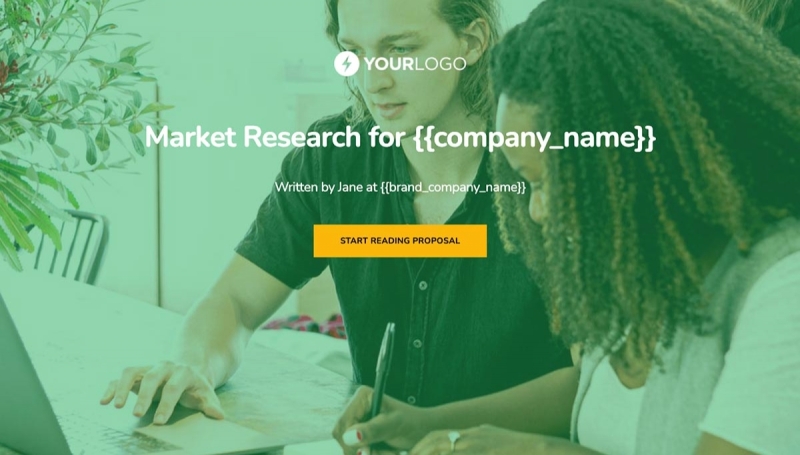
A look at everything in this Market Research Proposal Template
Stunning cover.
The first thing your client sees when your proposal shows up in their inbox is a nicely designed cover. As a business owner, you understand how hard it is to gain the client's attention, so the goal is to start the proposal with an attention-grabbing image.
You can change everything, from the text, logo, and background image to make it a better fit for your needs.
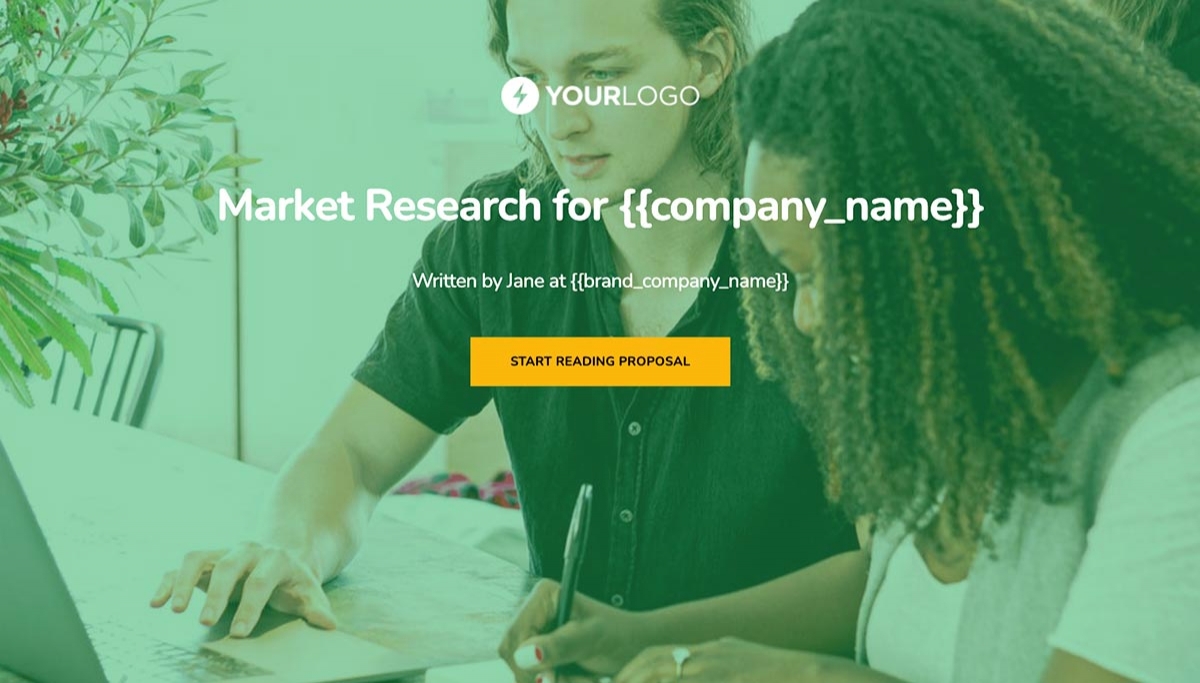
Pre-written introduction section
There is no better way to explain your market research plan to your potential clients than with our pre-written introduction section. It consists of a meeting summary, proposed research that includes everything from social media to focus groups, and a structured breakdown of your services. You just need to add a few client specifics and that's it.
Like everything else in this sample proposal, it's 100% editable - the colors, the text, images, layout - everything.

Processes and timelines
Explaining to the client the structure of each of the market research methodologies you are going to use can be difficult. You want to give enough detail about your data collection methods and how you generally conduct market research but not so much it seems overwhelming.
Fortunately, we created a plan of action already sectioned to fit the amount of information needed to design a perfect proposal. Just make a few adjustments to suit your exact process.
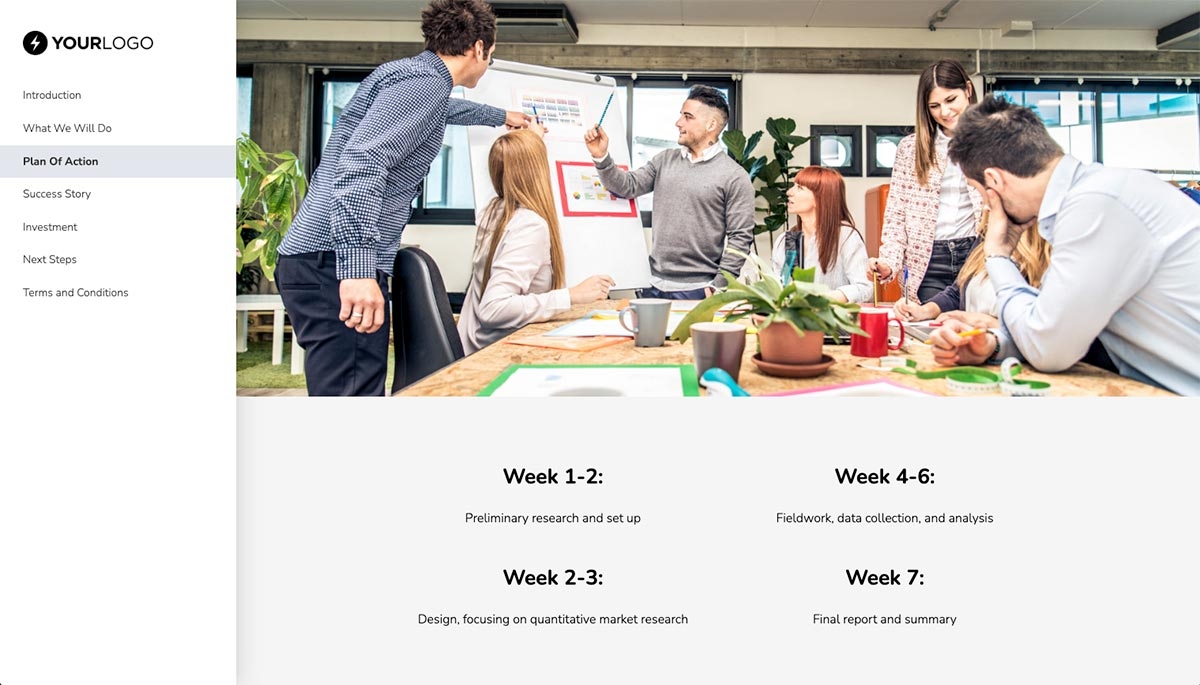
Case study example
A client success story is a powerful tool in convincing your clients to close the deal. It gives you the perfect opportunity to show them that you understand their goals and objectives and have a way to make them come true. In this market research proposal template, we've set out an example case study.
All you need to do is replace our example with one of yours and use the structure we've used.
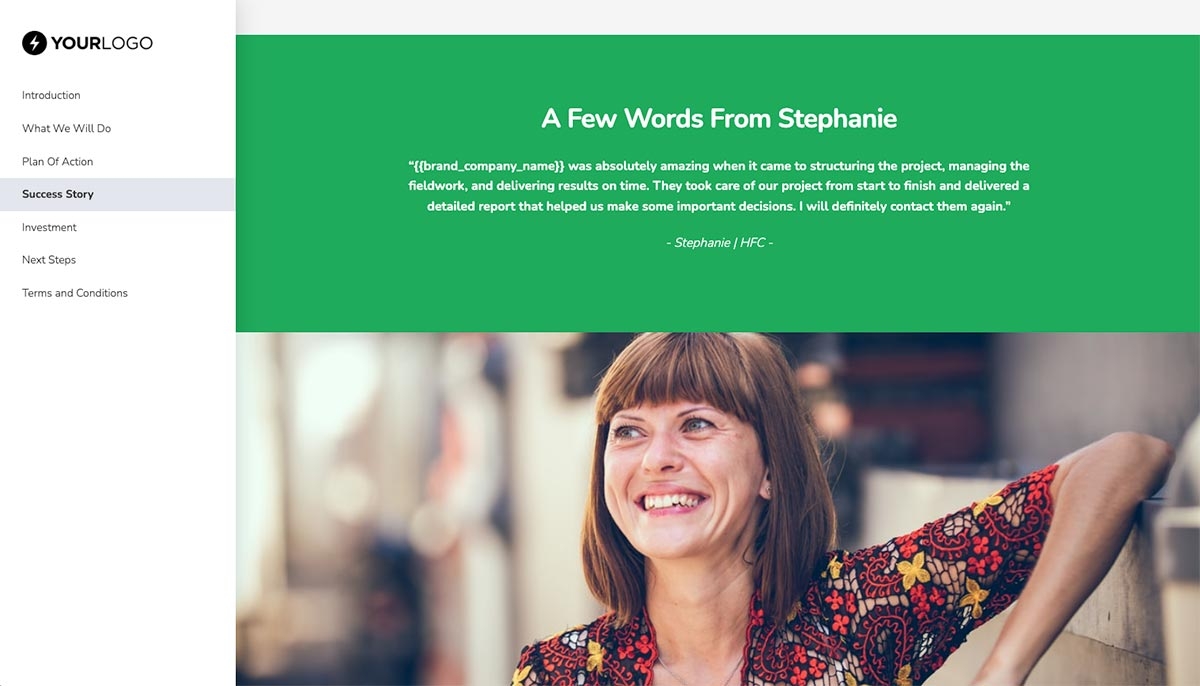
No matter if your pricing strategy includes charging hourly, monthly, or optional up-sell services, like special images and videos, you can do it all with this automatically calculated pricing table. The final steps are simple - just enter your numbers and a short description, and both your market research proposal and quotes are ready for your client's eyes.
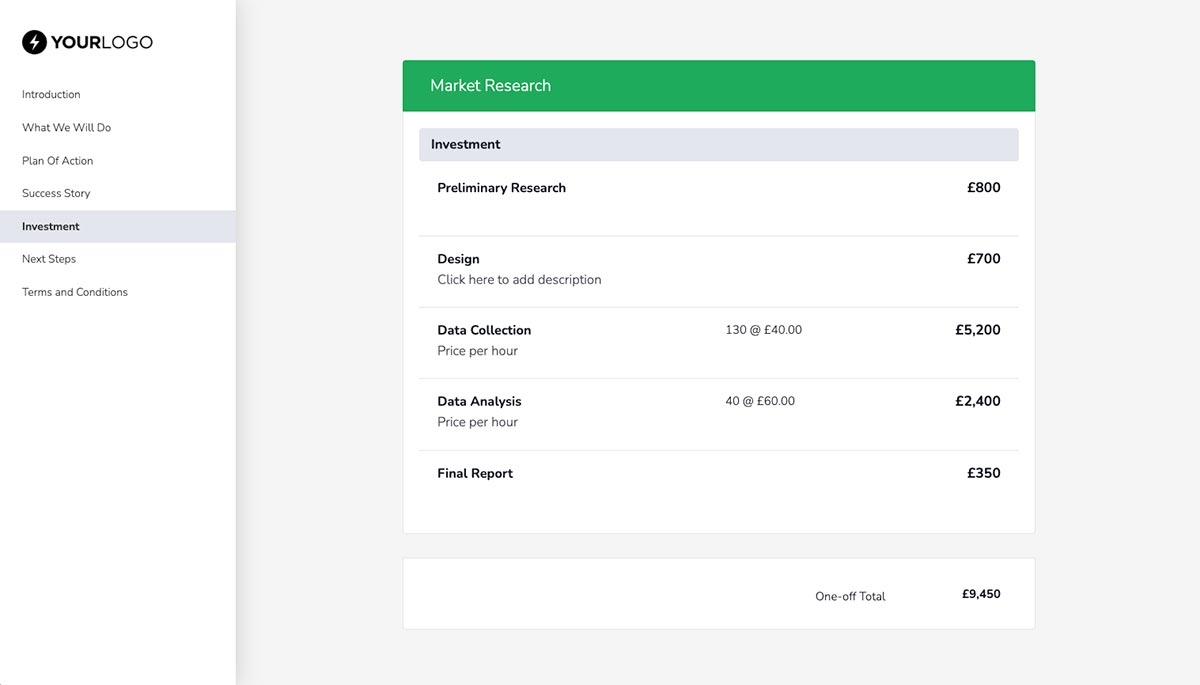
Next steps with digital signing
Any business will eventually be tested in handling increased customer traffic. Lessen the strain of paperwork by choosing a digital signature over traditional mail. The 'Next steps' tab will allow you to explain your process after signing and offer a line for the customer to give their electronic consent.
Our digital signatures are legal and compliant. When your client signs, you can see their digital signature certificate in your Better Proposals account.
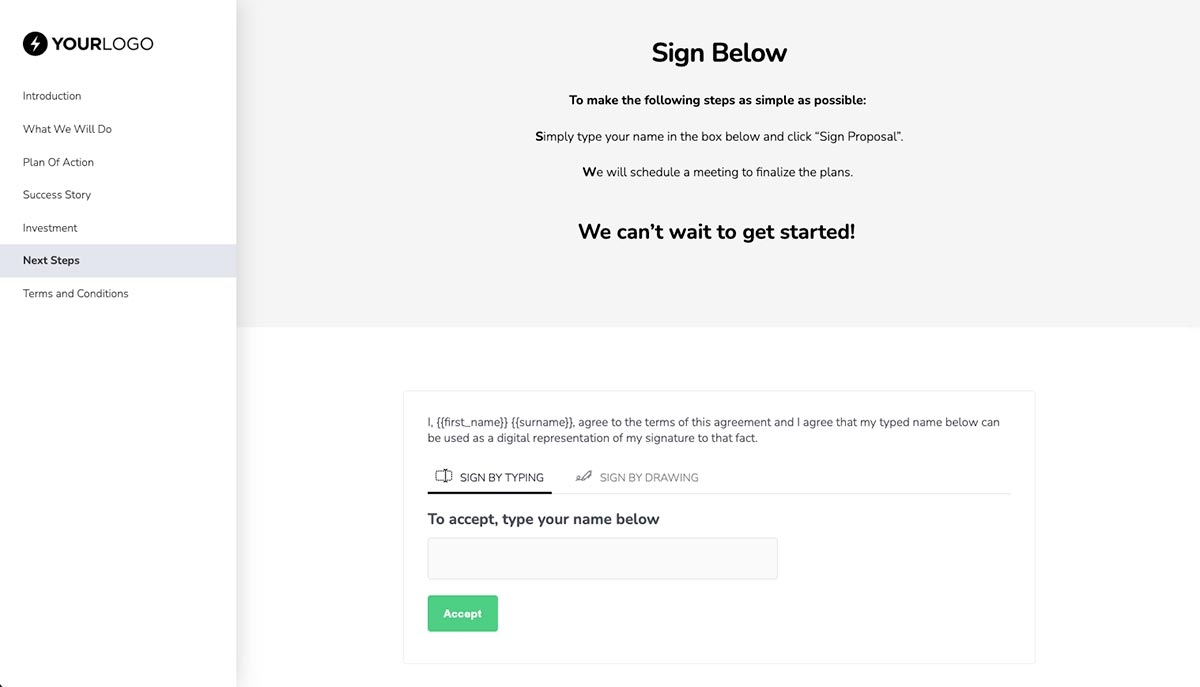
Pre-written contract
Whether you're just starting a company or you're a seasoned professional, Terms and Conditions will probably slip your mind when you're discussing some new market research projects. To ensure your business is still protected, we have added fully customizable T&Cs at the end of this template.
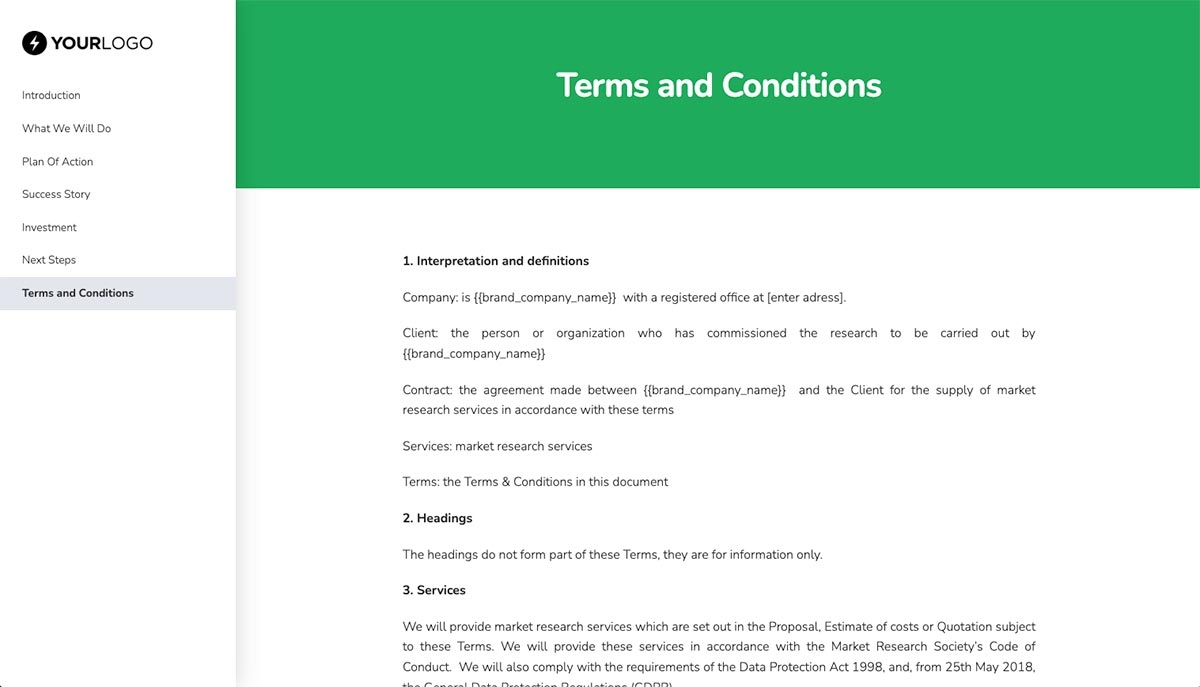
Take payments from your clients
Getting paid - it's the hardest thing to do in business. The sooner and the easier you can get that money in your account, the better.
Using our integrations with Stripe, PayPal, and GoCardless, you can take a payment from your client the moment they sign your proposal.

Don't take just our word for it
Here is what some of our 10,000 users across the globe have to say

Sara K. CEO & Founder

Shade O. Business Owner

Brent R. Marketing and Advertising
150+ other free proposal templates just like these are also available inside Better Proposals
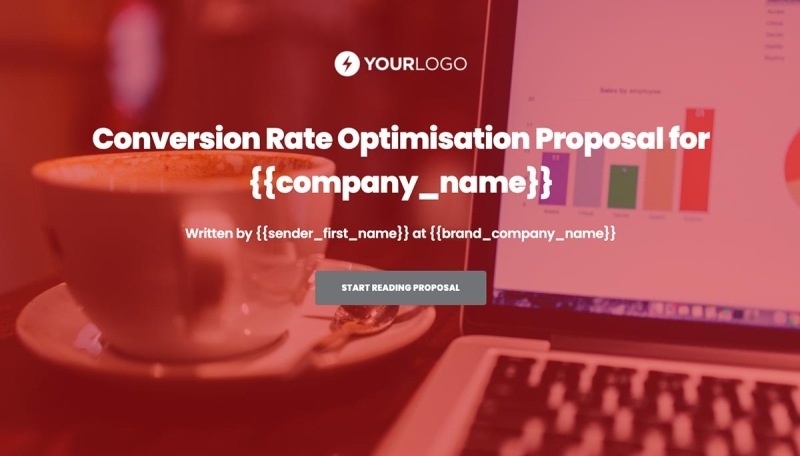
Conversion rate optimization should provide great results, and so should your CRO proposal. Explain your conversion rate optimization strategy, provide case studies and detail your results. Use this conversion rate optimization proposal to win new deals.
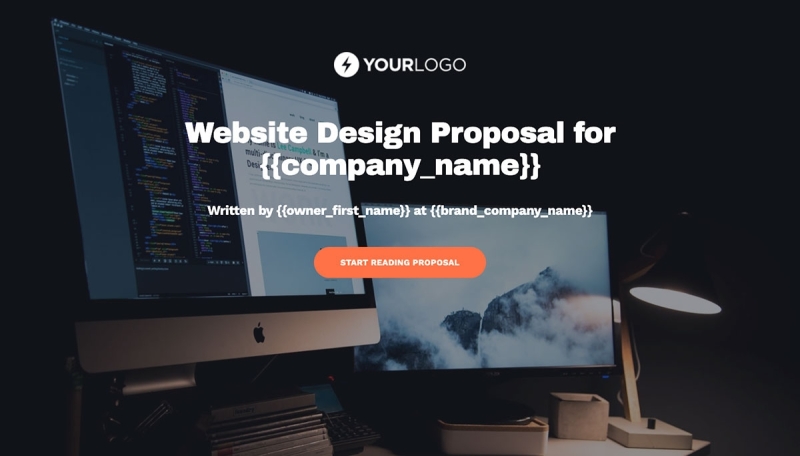
There is no better way to show off your stunning website designs than by using this website design proposal. Include your previous work and sweep your clients off their feet. Just edit a few details and your proposal is good to go.
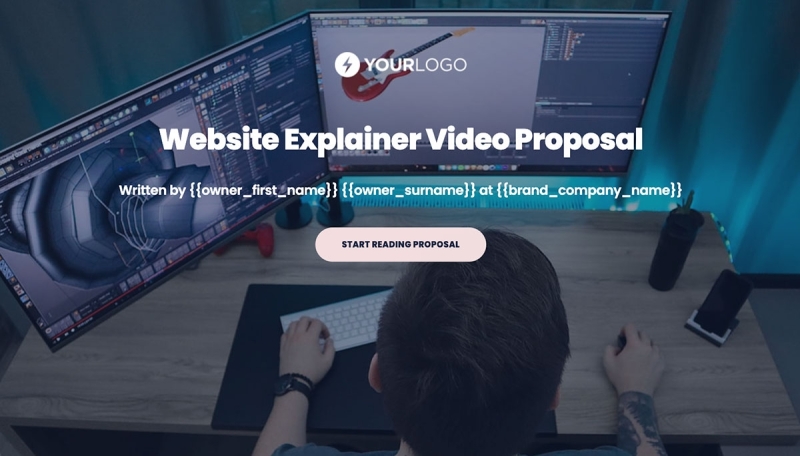
Website explainer videos are one of the best ways to show what you do in a short clip. If you want to show off your work and instill confidence in your client that you are the right person for the job, this proposal template is all you need.
Automate your sales process with our 50+ integration partners
Import your contacts from a CRM, receive payments, chat with prospects and manage projects. All in once place. See all integrations

Your questions, answered
Common questions about plans, designs and security
Start sending high conversion proposals today
Join 10,000+ happy customers and enjoy a simpler, faster, and more professional way to win more business.
No credit card required. Cancel anytime.

Market Research Proposal Template To Close Deals
Companies that conduct market research and analysis can use our sample marketing research proposal template as an example of how to write a market research proposal, and as a guide when preparing survey proposals, data collection proposals, or business research.
This template allows you to explain your methodology for gaining qualitative and quantitative research, and provides a section to break down your research timeline into phases. It also includes a statement of work section to clarify what the customer will receive from the research, along with a detailed contract

All Proposify proposal templates are 100% customizable.

Executive Coaching Proposal Template
Companies preparing proposals coaching services can use this executive coaching proposal template when pitching their services to potential clients.

AdWords & PPC Proposal Template
The perfect pitch guide for marketing agencies offering pay-per-click (PPC) advertising services like search engine marketing (SEM) and Google Adwords.
Learn why over 10,000 businesses love Proposify
Drag & drop library sections
Managing proposals is a breeze in Proposify. Save all your case studies, fees, images and team bios all in one central library.
Tag them, search them and drop them into your layout. Proposals just got... dare we say... fun?
Online previews & signatures
No more emailing big PDFs, printing and shipping proposals or faxing back signatures (ugh). Your client gets a branded, interactive proposal they can sign off electronically. No need for extra software or logins. Oh, and we tell you as soon as your client opens it.
Track everything
Keep a pulse on your the sales pipeline of your agency. Proposify lets you know your close rate, which sections of your proposals get viewed and for how long, and all kinds of insight into what goes into your most successful proposals so you can sell smarter.
Sync up your other apps
Proposals are just one part of your agency sales process. We tie together your other software, so you can import contacts from your CRM, auto create deals and generate invoices in your accounting software. We are regularly adding new integrations.
Customer Support to the Rescue
We understand that when you’ve got questions, especially when you’re on a tight proposal deadline, you NEED answers. Our customer happiness specialists are at the ready, armed with friendly, helpful, timely support by email or online messaging. We’re here to help, regardless of which you plan you’re on or if you’re just taking us for a test drive.
We Keep Your Data Safe and Private
When it comes to protecting your private information, we’ve got it locked down tighter than Alcatraz. We partner with Amazon Web Services, use 128-bit SSL encryption, and create daily backups. And we never, EVER disclose any data to third-parties without your permission. Rest easy, nothing’s getting out of here alive.

Ready to see Proposify in action?
Sign up for a custom demo to give Proposify a test drive and get all your questions answered.
404 Not found
How to Write a Great Market Research RFP
May 30, 2018
Whether you're writing a Branding RFP, Brand Research RFP, Marketing Consultant RFP, Strategy Firm RFP, etc., our template will save you time and help you evaluate and choose the best partner.

Writing a Request for Proposal is no easy task, but RFPs don’t have to be painful. With no standard template and heaps of information to consider, the process can feel daunting and confusing. Challenges withstanding, it’s important to get it right. The quality of your RFP has a direct impact on the quality of your project’s outcome – for better or for worse. Complete the form to download our guide on How to Write a Great RFP. Inside you’ll find:
- A detailed checklist of what to include in your RFP
- Example RFP template to help guide you
- Examples of the ideal formats, context and information pieces that elicit solid proposals and ensure clear communication
Complete the Form Below to Download the White Paper
Thanks for downloading. Click below to access your copy of "How to Write a Great RFP". Enjoy!
Perspectives
Sign up for the latest tips to grow your brand., workshop playbook: 8 exercises to spark innovation, 10 lessons from journalism: how to use storytelling for your brand, customer segmentation strategy: build market segmentations with real business impact.
Free Marketing Research Proposal Template
Fully editable with custom branding and templated offering.

Bonsai has helped create 1,023,928 documents and counting.
Table of contents

What is a Marketing research proposal?
A marketing research proposal is a document designed to sell your services by showing potential clients the research that you will carry out for their project. Whether you’re a freelance marketing consultant or you have your own marketing agency, a market research proposal will cover what research needs to be done, how you’ll go about it, and why they should choose you for the project.
A proposal is typically one of the first points of contact that you have with an organization. Therefore, it’s a chance to make a strong first impression.
Note: Sign up now to get your free marketing research proposal template that will make yours stand out for all the right reasons.
What to include in the Marketing research proposal
A market research proposal will outline your market research plan and each critical step you need to take to perform the necessary research. It usually consists of three parts.
- Introduction: This includes project objectives and scope, target market, and methodology, including data collection methods.
- Discussion: This covers existing knowledge of the market, case studies or competitor analysis, a project timeline, proposed budget, deliverables, and ethical considerations.
- Summary: This concludes what you expect to achieve from the market research, how it will support the initial objectives, and why your company is the best for the job.
Introduction
At the top of any market research proposal template should be the title of your document followed by who it has been written by and who it’s for. You can also include both company addresses here if you wish.
Proceed to outline the project description and the purpose of performing the market research. What are you trying to achieve? Why is this research needed? Who will be conducting it? What problem are you trying to solve for the client?
You should also include a methodology section in your introduction. The research methodology should dive into what primary and secondary research will be conducted, how data will be collected, and the expected outcomes. As a freelance researcher, you’ll already know this, but it’s worth covering what’s included in each to the client:
- Primary research is research that you carry out yourself in the form of two research methods: qualitative and quantitative research. Qualitative research relies on first-hand observation from things like interviews, questionnaires, and focus groups. Quantitative research, on the other hand, relies on the collection and analysis of data from an online survey and polls.
- Secondary research is research that has already been published and comes from secondary sources. This may include academic literature, print publications, and online studies.
It’s important to give an overview of your target audience in your methodology too.
For instance, if your client is trying to determine whether it’s a good time to launch a new product, your methodology in your market research proposal would explain how you plan to arrange a focus group with their target audience of females aged 16-24. Being present in the meeting, asking the right questions, and making notes to refer to later on would confirm whether the prospective product could be useful and — ultimately — successful.
The discussion section of your marketing research proposal is typically the meatiest. It’s where you should demonstrate what you already know about the industry and company, while getting into the finer details of the market research project.
- Existing Industry Knowledge: Prospective clients are likely going to want to hire someone who knows what they’re talking about. Right? Demonstrate that’s you by discussing the market and how it’s being affected in terms of the PEST analysis (politically, economically, socioculturally, and technologically). You can also cover case studies or a competitor analysis of companies that have already undertaken the same research and achieved similar goals.
- Timeline: For the research items that you listed in your methodology, include time frames of when each one will be conducted. You don’t have to be super precise here — it’s more about giving your client a realistic idea of the timings of key project milestones. However, exact details can be tweaked and laid out in a marketing research contract once your proposal and project quote has been approved.
- Proposed Budget: Any market research proposal template has to include a budgeting section. This is where you would break down how much you expect the research to cost, while offsetting it with how the client can make the most out of their investment. Just like with the timeline, the information doesn’t have to be exact at this stage. It’s more a rough estimate to ensure that the project expectations of both parties align.
- Deliverables: This section should answer any questions that a prospective client may have on the general organization of the project. In other words, it should tell them how you plan to present the research and its findings, whether it’s in the form of a one-off report, series of meetings, or collaborative Google Docs. You may choose to hand-deliver a printed copy of your findings or email through a PDF file. Either way, this section is a significant part of a market research proposal as the findings taken from the document need to be actionable by the marketing team.
- Ethical Considerations: This part of the market research proposal should outline any ethical issues that may arise throughout the course of your research, from conflicts of interest to concerns about supplier relationships. It should also cover how you plan to deal with participants, data gathering, and privacy issues before the project has even begun.
For example, you may write something like the following: “Each participant will be told that their input in this research is voluntary. They will be provided with a form to assure them that their data will remain confidential for the purposes of this research and won’t be used by third parties. They must sign this form in person or we can accept digital signatures to consent to these terms.”
The summary tends to be the shortest section of your market research proposal. It’s where you would refer back to the initial project objectives and conclude the desired outcomes from the market research.
It’s a good idea to end on a punchy note by describing why your potential client should become an actual client.
- What can your company offer to this project that no other company can?
- Why are you the perfect person or team to perform the research?
- What makes this proposal unique?
Don’t lose sight of the fact that you’re trying to convince somebody (or some people) of your value. You want them to take action after reading your proposal, which is why you should include a compelling Call-To-Action (CTA). Let them know what the next steps entail, and how to take them.
How to write a Marketing research proposal
The truth is, it’s difficult to draft a market research proposal without some key information from your prospective client.
To gather all of the details you need to create a winning marketing research proposal, follow the below steps.
Find out exactly what the client wants to achieve
During your initial email or phone discussion, ask your client what they want to get out of the research. Are they rebranding and want to redefine their target market? Or are they testing out a new product with a small group of people before unleashing it to the masses?
Either way, it’s useful to know their final goals so that you can start to make a plan on how to help them achieve them.
Discuss the finer details
Alongside your prospective client’s research objectives, you need to find out more details in terms of their:
- Target demographics
- Project deadline
- Project budget
You should also ask them if there’s any other key information that they would like you to include in the market research proposal. This will ensure that you have everything you need upfront without having to make extensive edits later on.
Figure out what sets you apart
Keep in mind that you haven’t been awarded the job yet. A work proposal is essentially a sales document — it almost serves as a resume before the client decides that you’re the ideal person to hire.
As such, do some company research to put you ahead of your competition. Is there a link you can make with the company based on your background and interests? Why should they care about you? What do you offer that no one else does?
Be sure to feature all of this information in your market researching proposal, and don’t be afraid of highlighting your strengths and wins.
Creating a Marketing research proposal is simple with Bonsai
There's plenty to think about when conducting marketing research, which is why you can make life a little simpler with Bonsai. Bonsai's all-in-one tool for small businesses, freelancers, and entrepreneurs streamlines administrative tasks and covers all bases when it comes to proposals, contracts, and invoices.
You can find a template specific to market research and edit it to meet your needs in minutes. Then all you have to do is send it off to your client, which you can do without even leaving the platform. Talk about a time- and energy-saver!
The marketing research proposal template is professional and refined in structure. This provides clarity to your potential client by laying out exactly what you can do for them within their timeline and budget.
Simply enter your information, sit back, and be prepared to wow your prospective client so much that they hire you on the spot.
Note : Sign up for free and get started!
Marketing research proposal FAQs
How long should a marketing research proposal be.
A market research proposal should be concise and fluff-free. It should cover all the obligatory information without dragging it out. After all, prospective clients are busy reviewing other proposals and working on further aspects of their business.
The perfect length is between 1-2 pages, but try to ensure that it’s no more than 3.
What should the tone and writing style of a marketing research proposal be?
Because your market research proposal is only a couple of pages long, the writing style should be clear and easy to read. The language should be simple, everyday, and familiar, using short sentences that get to the point and won’t clutter up the document.
The tone of your plan should be informative and position you as the expert to leave a positive, long-lasting impression on your prospective client.
What is the main purpose of marketing research?
Marketing research aims to investigate and assess how certain factors influence consumer behavior. This provides key insights that are relevant to decision making.
Marketing research can identify new business opportunities and avoid business failures. That said, above all, it can be used to inform a company’s marketing strategy to help them achieve their business goals.

How do you write a marketing research proposal?
What is market research and examples, what is research proposal template.
Marketing Agreement Template
Free Influencer Collaboration Agreement Template
Free Co Marketing Agreement Template
Free Social Media Contract Sample for Your Business
Free Social Media Invoice Template
Free SEO Invoice Template
Free Public Relations Invoice Template
Free Marketing Invoice Template
Free YouTube Marketing Proposal Template
Free Social Media Proposal (RFP)
Free Social Media Marketing Quotation Template
Free Digital Marketing Quotation Template
Free WordPress Website Proposal (PDF)
QuickBooks Proposal Template
Spec Sheet Template
Free Website Redesign Proposal Template
Free Website Proposal Template
Free Video Production Proposal Template
Free Website Development Proposal Template
Best Virtual Assistant Proposal (Free & Customizable)
Free Translation Proposal Template
Free UX Design Proposal Template
Free Software Development Proposal Template

Market Research Proposal
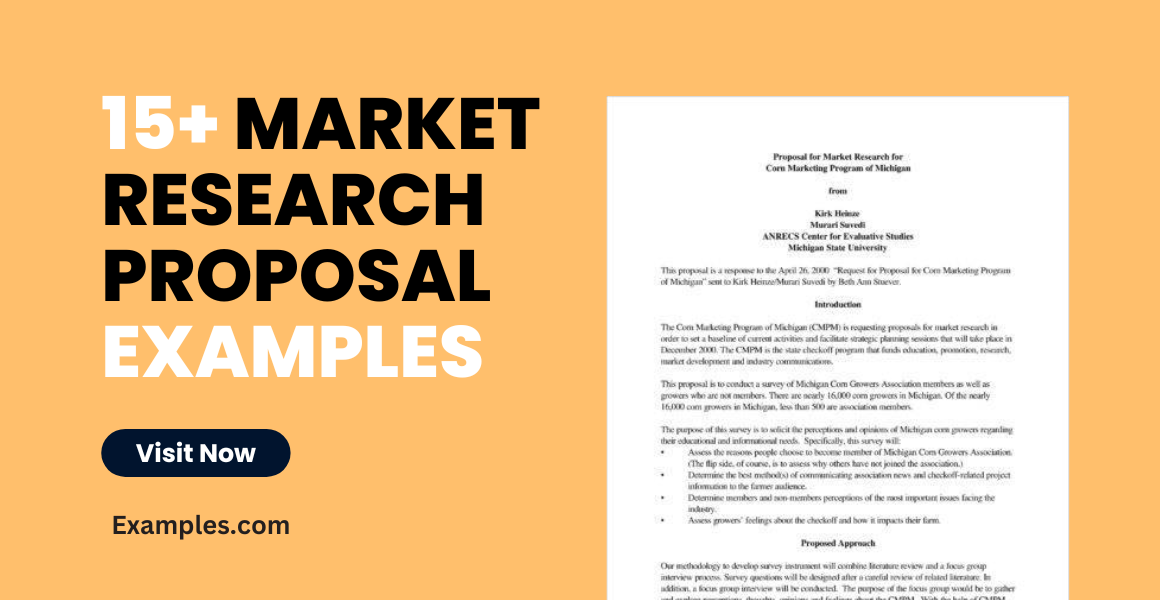
Setting the direction for any market research effort is an essential and critical step that you have to consider whenever you would like to look into the trends in the marketplace or assess the key factors that affect the purchasing decisions of your target audience. Before doing any program or activity related to the specified matter, you first have to know how to execute an effective proposal writing procedure.
Developing a comprehensive and detailed market research proposal can help you a lot in terms of organizing the market research processes that you would like to conduct as well as the resources that you will be needing.
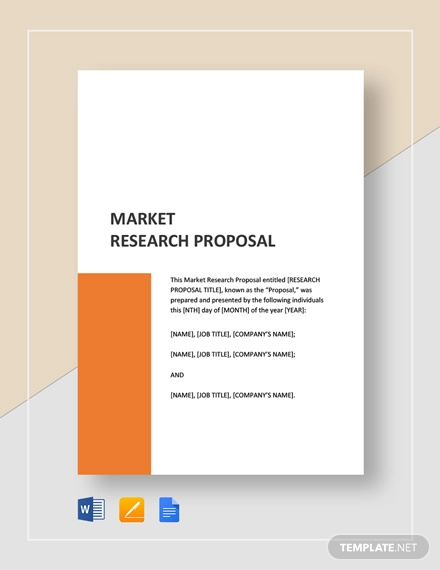
- Google Docs
Size: A4, US
State the objectives, scope of work, research methodology, target market, and other such important information of your market research by downloading and using this above-shown research proposal example template. This ready-made template’s content can be edited and customized in various file formats such as MS Word, Pages, Gooogle Docs, and editable PDF. Hurry up and try it out now!
Market Research Proposal Example
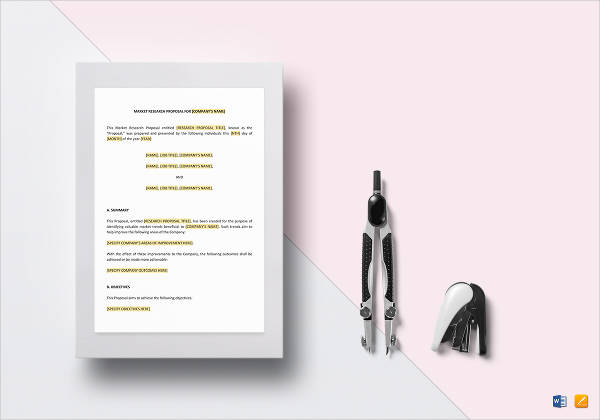
Download and make use of this market research template so that you can conduct your market research effectively. Using this, you can conveniently outline the objectives and goals for your market research, thereby, saving you enough time to do other tasks related to the research. Edit and customize using MS Word and Pages. You can also click on multimedia project proposal examples .
Marketing Research Proposal Example

It is important to not let yourself get confused between a market research proposal and a marketing research proposal. The marketing research proposal deals with the presentation of potential promotional and advertising activities that can be implemented by a company to present and market its products, services, deals, and other offers while the marketing research proposal is focused on learning the market movement based on the market’s trends, activities, and size.
Proposal for Market Research Example
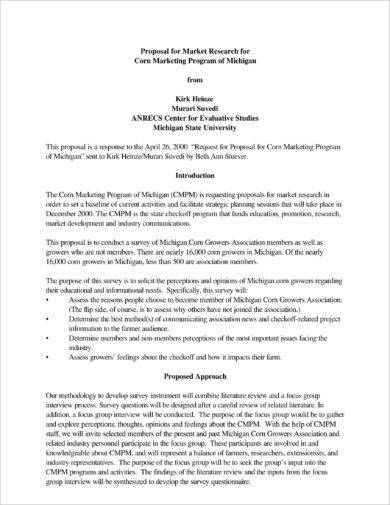
Size: 10 KB
If you want to create your market research proposal, one of the things that you can do to help you have an easier time when developing the document is to look into references like downloadable examples. Simply browse through the market research proposal examples in PDF that are available in this post so you can have an idea of how to properly create the best market research proposal for your business.

Free Market Research Proposal Example

Size: 340 KB
Importance of a Market Research Proposal
A market research proposal helps you properly think of the things that truly matter when it comes to the market research. With the help of this document, you can give priority to the factors and elements that can contribute to the advancement and growth of your business .
Using a market research proposal can also give you time to put together relevant and necessary processes that are most likely helpful in achieving not only the goals of your market research activities but the corporate goals of the business as well. Here are some of the reasons why you need to create and use a market research proposal:
1. A market research proposal is one of the most essential documents that are used by businesses to properly plan the entire process of their market research activities. It presents the outline of the market research’s goals and it also focuses on the action plans that can lead the business to the achievement of its objectives and vision.
2. A market research proposal can give an idea about the funding that is needed by the team to execute the activities for market research. Financial support from the organization is needed to be addressed to make sure that all plotted procedures will be implemented accordingly. You may also see business proposal examples .
Developing the market research proposal with the knowledge that funding will be given for its implementation can make the marketing team, as well as the other people involved in the activity, become more proactive and efficient as it is most likely that what they envisioned and planned will be realized.
3. A market research proposal, especially one that contains a marketing SWOT analysis and a market condition overview, can help you look into the external and internal factors that affect your business operations.
The knowledge about the nature of your business, the competition that you need to look out for, the threats and risks that you need to prepare for, the needs and demands of your audience, the movement and shifts in the marketplace, and the opportunities that you should grab can make you become more well-rounded and multifaceted when drafting the market research proposal that you would like to present. You may also check out project proposal examples .
4. A market research proposal can discuss the milestones that are expected to be achieved by the business with the help of market research strategies and general action plans . Hence, this document can persuade and convince its target audience that a proposed market research activity must be approved especially if expected results can excessively benefit the business or provide a solution to its current issues, problems, and concerns.
Sample Marketing Research Proposal Example
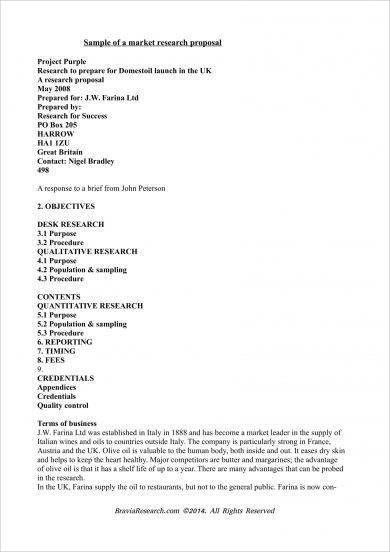
Size: 90 KB
Proposal for Marketing Research and Market Intelligence Example

Size: 607 KB
Market Research and Analysis Report for Proposal Referencing Example
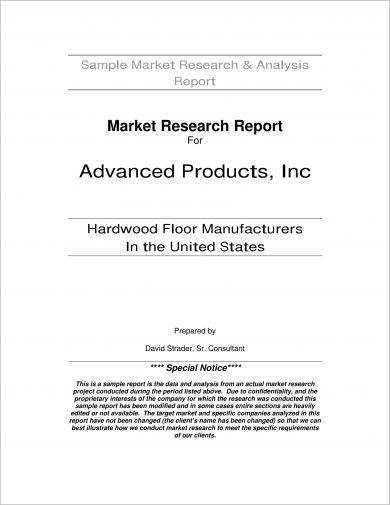
Size: 152 KB
Market Research Proposal Content
Different market research proposals have different sections, clauses, or areas of discussion. The content of a market research proposal depends on the purpose of its usage, the scope of the activity, the expected returns of the business, the professional goals of the market research, and the relation of the document’s usage to the vision of the business.
Even if there are differences when it comes to the information that you can see in many market research proposals used in various industries, there are still common or usual information that is seen in any market research proposal. Some of the details that are essential to be included in a market research proposal are as follows:
1. Develop a hypothesis. This is very important as you need to present the potential impacts of the market research proposal when implemented. This can also help you identify the ways on how you can interlink or align all the elements that are essential for the successful execution of all the market research proposal’s areas. You may also see short proposal examples .
2. Present an overview of the market research activities that you would like the business to consider. You have to sum up the intent of the market research as well as the output that you expect from it. More so, you have to discuss the feasibility, attainability, and sustainability of your general plans . Being able to showcase these strengths can help your market research proposal become more appealing and relevant.
3. Just like when making a development project proposal , use a timeline that can give an idea of the entire duration of the market research proposal’s actual usage. You have to set time frames where specific deliverables should be seen or observed already. With this, you can ensure your target audience that the proposal is time-bound and realistic.
4. Especially if you will use technical terms, a proper definition of terms is highly suggested to be included in your market research proposal. This part of the document can make the general proposal more understandable for any reasonable person.
5. Know your targets so you can easily come up with the methodology that is relevant to your needs. All the practices and activities that you would like to immerse in should be thoroughly defined in the document so that the general analysis of the measures of your proposal can be objectively done.
6. Discuss the current market conditions in the marketplace where your business belongs. Aside from the trends that you need to consider, you also have to list down the opportunities that the business can take to help it achieve its goals and return of investments.
Marketing Information Management System Research Proposal Example
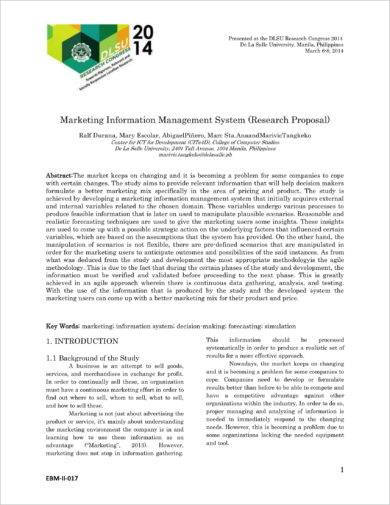
Size: 399 KB
Research Proposal Usable for Market Study Example
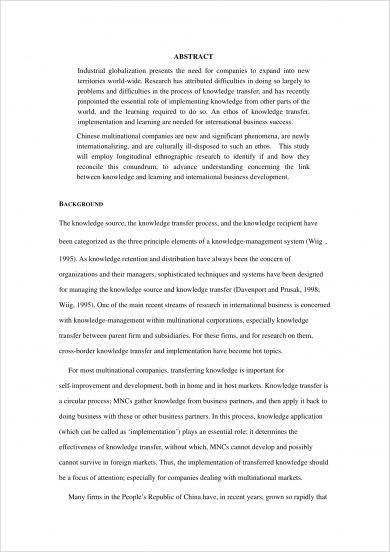
Size: 99 KB
Market Research and Developing a Marketing Plan Proposal Example
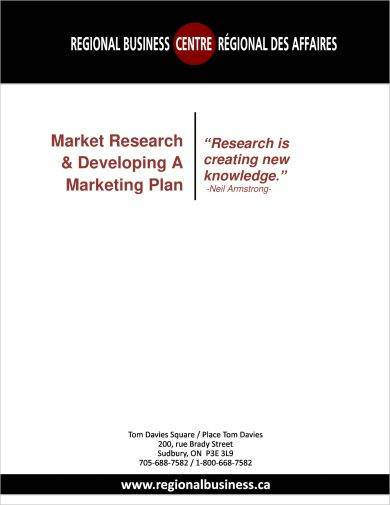
Market Research Conduct and Proposal Drafting Example
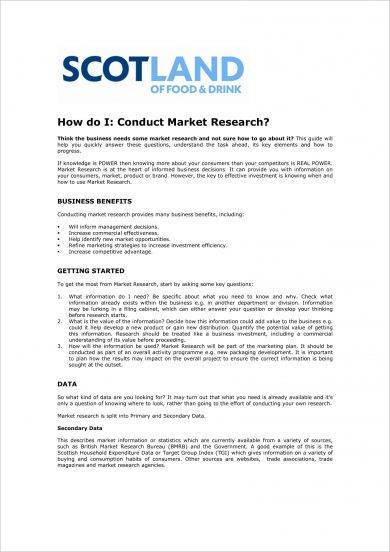
Size: 131 KB
Discussion Flow for a Simple Market Research Proposal
The format and discussion flow of the market research proposal can contribute to the document’s successes, or the lack thereof. This is the reason why you have to be careful with how you will present the market research proposal to your audience. You have to ensure that the document is visually pleasing and well-organized so that people will not have a hard time reviewing its content. You may also see freelance proposal examples .
A basic discussion flow that you can use when presenting the details of your market research proposal are listed below:
- The title of your market research proposal sample
- The date when the market research proposal has been made and the dates of its updates
- The name of the company who can benefit from the document
- The name of the person who prepared the proposal and the department or division where he or she is assigned at
- The executive summary of the market research proposal
- The objectives of the market research proposal
- The current condition of the business and the market as well as other important existing knowledge
- The expected output of the document’s usage, when approved
- The demographics targeted by the business with the help of the market research proposal
- The processes of data gathering, collection, assessment, and presentation
- The methodology that will be applied for the research project plan intended for a particular market
- The dates and periods where particular tasks should already be done
- The budget proposed by the team or the individual who made the proposal
- Any ethical considerations that must be looked into before the implementation of the market research
Proposal to Conduct Consumer Experience of Care Surveys or Market Research
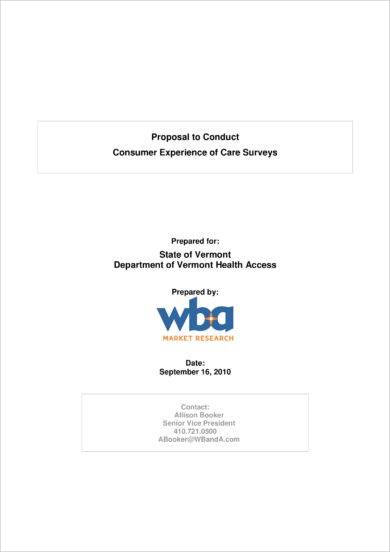
Size: 103 KB
Request for Proposal for Solicitation for Contract for Market Research Example
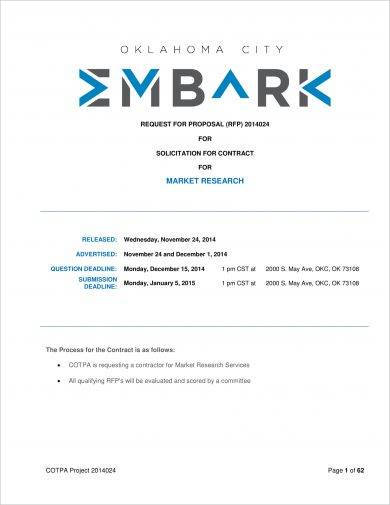
Size: 344 KB
Marketing Research Group Project Proposal Example
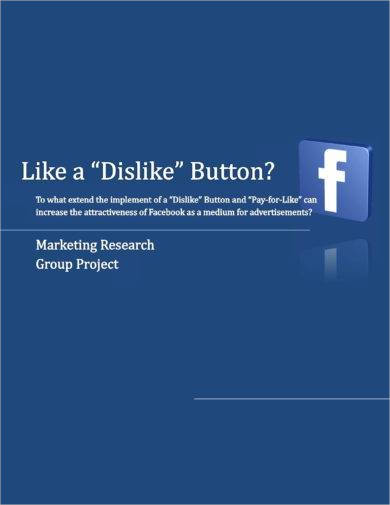
Marketing Research Firm Proposal Example
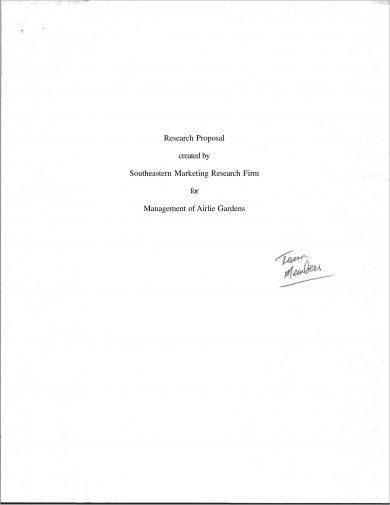
Size: 477 KB
Tips to Develop an Impressive Market Research Proposal
Aside from having an advertising and marketing business plan , you should also have a market research plan. It is not enough for you to rely on your knowledge about the things that you can control. You also have to think of the elements that are not within your hands like the trends in the marketplace and the reaction of your audience and competition with regards to these trends and/or any other market changes.
Listed below are a few of the tips that you can use if you want to develop an impressive market research proposal for your business:
1. Since a market research proposal is one of the first documents that you will be needing for your market research, you have to ensure that the content of the document is flexible enough to adapt to possible changes within the development of the market research planning and implementation phases. You have to ensure that there are windows where appropriate changes can be inserted as well as channels, mediums, or platforms where you can incorporate backup plans when necessary or called for.
2. Keep in mind that the language and tone that you will use when creating the content of the market research proposal must be highly considered.
You have to ensure that the document is formal, business-appropriate, and compelling. Aside from the fact that the market research proposal is expected to be complete with all the details about your proposed market research plan, it is also imperative for you to make sure that the document is understandable, well-defined, and clear. You may also see security proposal examples .
3. Know the basics of market research proposal organization. There are different kinds of structures that you can look into so that your market research proposal can look cohesive and well put together.
The structure of the document should depend on the length of your discussion, the details that you will incorporate in your market research undertakings, and the key factors that you need to give focus and highlight on when presenting the complexity of the market research. You may also like budget proposal examples .
It will rather be more efficient for you if you plan to use references like templates and examples while preparing your market research proposal.
Maximize the help that you can get from the downloadable examples in this post as well as the related discussion that we have presented. Always ensure that there is an organization in the procedures of market research proposal development so you can be well-guided in terms of getting the output that you would like to have for your market research undertaking.
Proposal Maker
Text prompt
- Instructive
- Professional
Generate a proposal for a new school recycling program
Compose a proposal for a school field trip to a science museum.
Work With Us!
- Call Now: +1 (866) 277-7275

- Product Marketing & Management
- Demand Generation & ABM
- Sales Enablement & Training
- Strategic Communications
- View All Topics
- Agency Management
- Agile Marketing
- Blogging for Business
- Content Marketing
- Crisis Communications
- CRM Program
- Customer Engagement
- Demand Generation
- Event Marketing & Trade Shows
- Lead Generation
- Market Research
- Marketing Communications
- Marketing Strategy
- Mobile Marketing
- Online Advertising
- Online Community
- Product Development
- Product Marketing
- Project Management (PMO)
- Public Relations
- Sales Enablement
- Sales Training
- SEO & SEM
- Shopper Marketing
- Social Media Marketing
- Video Marketing
- Webinar Program
- Website Redesign
- Most Popular Tools
- Assessments
- Business Cases
- Calculators
- Competitive Analysis
- Job Descriptions
- Prioritization Tools
- Process Diagrams
- RFP Templates
- ROI Calculators
- Skills Assessments
- Project Plans & Charters
- Strategy Scorecards
- Vendor Evaluations
- Benchmark Reports
- Best Practices Guides
- How-To Guides
- Masterclass: Commercial Excellence
- View Training Courses
- View On-Demand Webinars
- About DM University
- DM University Login
- Custom Playbooks
Market Research RFP Template
Resource overview.
A template to create a request for proposal (RFP) for market research support services.
Related Resources
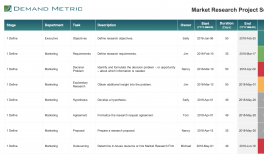
Your Problem
You need to hire a market research firm for a project, and it is required that you put together a Market Research Request for Proposal (RFP).
Our Solution
We created the Market Research RFP Template to help you generate a request for proposal (RFP) for market research support services. Sections include: Company Information, Statement of Work, Proposal Submission Procedure, Scope of Work & Business Requirements, Vendor Information, and Estimated Budget & Resources Required. The purpose of this RFP is to help you find a market research firm to support you in a project.
This template works by allowing you to first enter basic information about your company, such as a corporate overview. You are then asked to define the statement of work and proposal submission procedure and to add an estimated budget and time required. This is a Microsoft Word-based tool that can be easily customized.
Key Benefits
- helps you get bids from multiple market research firms
- reduced cost of the project from competing bids
- provides all key project requirements
- save 4 hours on writing & formatting
- provides a real-world example
Microsoft Word Document
Estimated time required: 1 hour, skills required: rfp writing.
Want to transition into consulting that pays $25K/DAY?
- Tools & Templates
- Training Courses
- Join LinkedIn Group
Want to work with us?
- Book a Free Consultation
Total Members
New last week.
- Terms of Use
- Privacy Policy
- Call Us 1 (866) 277-7275
- For Small Business
RFP: How to Write a Strong Request for Proposal [Example & Template]
- May 13, 2024
- by steven-austin

How to Write an Effective RFP (Request for Proposal) in 2023: Templates, Examples, and Best Practices
When your business needs to find the perfect vendor for a project, a well-crafted RFP (Request for Proposal) can be your most powerful tool. An RFP is a document that outlines your project requirements and solicits bids from potential contractors or agencies.
A great RFP clearly articulates your needs, timeline, and budget, while inviting high-quality, tailored proposals from vendors. On the flip side, a poorly written RFP can result in misaligned bids, unqualified vendors, and costly project delays.
In this guide, we‘ll walk you through everything you need to know to create effective RFPs in 2023 and beyond. From key components and best practices to customizable templates and real-world examples, you‘ll learn how to master the RFP process and find your ideal vendor match. Let‘s get started!
What is an RFP (Request for Proposal)?
An RFP is a formal document that businesses use to solicit proposals from potential vendors for a specific project or solution. It outlines the company‘s requirements, project scope, budget, timeline, and evaluation criteria.
The purpose of an RFP is to collect detailed bids from a variety of vendors and objectively compare them to select the best partner. RFPs are commonly used for complex projects that require specialized skills or technology, such as software development, marketing campaigns, research studies, and construction.
RFPs vs. RFIs: What‘s the Difference?
Before we dive into writing an RFP, it‘s important to note the difference between an RFP and an RFI (Request for Information). While they may seem similar, they serve distinct purposes:
An RFI is used earlier in the procurement process to gather general information about potential vendors and solutions. It helps businesses understand the market landscape and define their project requirements.
An RFP, on the other hand, is used when a business has clearly defined project needs and is ready to solicit detailed proposals from qualified vendors. RFPs dive deeper into specifics like scope, deliverables, timeline, and budget.
In short, an RFI is for exploration, while an RFP is for vendor evaluation and selection. For the rest of this guide, we‘ll focus on RFPs.
How to Write an RFP: Step-by-Step Guide
Writing a comprehensive RFP can seem daunting, but breaking it down into key sections can make the process more manageable. Here are the essential components to include and tips for crafting each one effectively:
- Background and Company Overview Begin your RFP with a brief introduction to your company and the purpose of the document. Provide high-level information about your business, industry, and any relevant context for the project. This helps vendors understand who they‘ll be working with and align their solutions accordingly.
- Keep the company overview concise but informative
- Highlight your mission, values, and competitive differentiators
- Mention any key stakeholders or decision-makers for the project
- Project Goals and Scope In this section, outline the specific objectives and deliverables you expect from the vendor. Be as detailed as possible about the project requirements, features, and functionality. If relevant, mention any technical specifications, compatibility needs, or compliance standards.
- Use clear, specific language to describe your project needs
- Break down complex projects into phases or milestones
- Provide measurable goals and success metrics
- Specify what is in-scope vs. out-of-scope for the project
- Budget and Timeline Transparency is key when it comes to project budgets and deadlines. Include your estimated budget range and ideal project timeline, including any hard deadlines or milestones. This allows vendors to determine if they have the resources and availability to meet your needs.
- Provide a realistic budget range based on market research
- Clarify if the budget is flexible or firm
- Break down the budget by project phase or deliverable if applicable
- Include a timeline with specific dates for project kick-off, milestones, and final delivery
- Vendor Requirements and Selection Criteria Outline the specific qualifications, skills, and experience you require from potential vendors. This may include years in business, team size, industry expertise, technology proficiencies, or relevant certifications. Additionally, describe how you will evaluate and score proposals to select the winning bid.
- Be specific about must-have vs. nice-to-have vendor qualifications
- Consider including a vendor questionnaire to gather consistent information
- Develop an objective scoring rubric based on your selection criteria
- Clearly state any vendor disqualifiers or red flags
- Submission Guidelines and Contact Information Lay out the logistical details for submitting proposals, including the deadline, format, delivery method, and contact information for questions. Be sure to give vendors ample time to develop thoughtful, tailored bids while still moving forward with your project timeline.
- Provide at least 2-4 weeks for vendors to submit proposals
- Specify required file formats, page limits, and any other submission constraints
- Use a secure submission method like a password-protected portal or encrypted email
- Designate a single point of contact for vendor questions and communications
- Appendices and Supplementary Materials Finally, include any additional documentation or resources that vendors will need to develop a comprehensive proposal. This may include technical specifications, data samples, brand guidelines, NDAs, or past project examples.
- Organize supplementary materials clearly and label them accordingly
- Provide links to any large files or online resources
- Ensure all stakeholders review and approve the final RFP before distribution
- Consider using an RFP template to ensure consistency and completeness
Best Practices for an Effective RFP
In addition to including all the key components, here are some overarching best practices to keep in mind as you develop your RFP:
Be clear and concise: Use plain language and avoid jargon or acronyms that may confuse vendors. Be specific about your project requirements and expectations.
Provide ample context: Share relevant background information about your company, industry, and project goals to help vendors tailor their solutions.
Invite questions and clarification: Encourage vendors to ask questions or seek clarification before submitting their proposals. This can lead to more accurate and targeted bids.
Be realistic about budget and timeline: Provide a feasible budget and timeline based on your research and project needs. Unrealistic constraints can deter qualified vendors or result in subpar deliverables.
Focus on outcomes, not just deliverables: Clearly define the desired outcomes and success metrics for your project, rather than just the specific deliverables. This gives vendors more flexibility to propose innovative solutions.
Establish evaluation criteria upfront: Develop an objective scoring rubric based on your RFP criteria and share it with stakeholders before evaluating proposals. This promotes fair and consistent vendor selection.
Proofread and Polish: Before distributing your RFP, thoroughly proofread and edit it for clarity, consistency, and professionalism. A well-polished RFP signals attention to detail and commitment to the project.
RFP Template and Example
To help you streamline your RFP writing process, we‘ve created a customizable RFP template that you can download and adapt for your specific project needs. The template includes all the essential components and formatting tips discussed in this guide.
In addition, we‘ve provided a completed RFP example based on a fictional company seeking a vendor for a mobile app development project. The example showcases how to effectively complete each section of the template with specific project details and requirements.
Emerging RFP Trends for 2023-2024
As business needs and technologies evolve, so do the best practices for RFPs. Here are some key trends to consider as you plan your RFPs in the coming years:
Cybersecurity and data privacy: With the rise of remote work and cloud-based solutions, data security is a top concern. Include specific security requirements and ask vendors about their data protection measures.
Accessibility and inclusivity: As companies prioritize diversity, equity, and inclusion, RFPs are emphasizing accessibility standards like WCAG compliance and inclusive design principles.
Outcome-based pricing models: Rather than fixed-bid contracts, more RFPs are shifting towards outcome-based or value-based pricing, where vendors are paid based on the results they deliver.
Collaboration and agility: RFPs are moving away from rigid, waterfall-style project management towards more collaborative and agile approaches that allow for flexibility and iteration.
Sustainability and social impact: Companies are increasingly looking for vendors that align with their values and prioritize sustainability, social responsibility, and ethical practices.
By staying attuned to these trends and incorporating them into your RFPs, you can find vendors that are well-equipped to meet your evolving business needs.
Using RFP Software to Streamline the Process
For companies that frequently issue RFPs or manage complex projects, using dedicated RFP software can significantly streamline the process. RFP software typically includes features like customizable templates, automated workflows, vendor communication portals, and proposal scoring tools.
Some leading RFP software options include:
PandaDoc: Offers a user-friendly interface for creating, sending, and tracking RFPs, with customizable templates and integrations.
RFP360: Provides end-to-end RFP management, including vendor sourcing, proposal evaluation, and contract award.
Loopio: Streamlines the RFP response process for vendors, with automated workflows, collaboration tools, and a content library.
DeltaBid: Focuses on construction and infrastructure RFPs, with features like bid comparison, subcontractor management, and compliance tracking.
When evaluating RFP software, consider factors like ease of use, customization options, vendor support, and integration with your existing tools. Look for case studies or customer reviews that showcase how businesses have successfully used the software to improve their RFP processes.
Evaluating RFP Responses and Selecting a Vendor
Once you‘ve issued your RFP and received vendor proposals, it‘s time to evaluate the responses and select a winner. Here are some tips for objectively comparing proposals and making a confident vendor selection:
Assemble a cross-functional evaluation team: Include stakeholders from various departments who will be impacted by the project, such as IT, finance, marketing, and operations.
Use a consistent scoring rubric: Evaluate each proposal using the scoring criteria outlined in your RFP. Assign numeric scores and weights to each category to enable objective comparison.
Look for red flags: Watch out for proposals that are missing key information, make unrealistic promises, or show a lack of understanding of your project needs.
Consider cultural fit: In addition to technical qualifications, evaluate vendors based on their communication style, values alignment, and team dynamics. A strong partnership is key to project success.
Conduct vendor interviews or demos: For your top contenders, schedule interviews or product demos to get a more comprehensive understanding of their capabilities and approach.
Negotiate contract terms: Once you‘ve selected a vendor, work with your legal and procurement teams to negotiate favorable contract terms, including pricing, deliverables, timeline, and intellectual property rights.
Notify vendors of your decision: Promptly inform all vendors of your final selection, and provide constructive feedback to those who were not chosen. Maintain positive relationships for future opportunities.
By following a structured and objective evaluation process, you can select the best vendor to bring your RFP project to life.
Conclusion and Additional RFP Resources
Crafting an effective RFP is a critical skill for businesses looking to find the right vendors and solutions for their needs. By including key components, following best practices, and staying attuned to industry trends, you can develop RFPs that attract high-quality proposals and set your projects up for success.
Remember to:
- Be clear, specific, and realistic in your project requirements and expectations
- Provide ample context and invite vendor questions and clarification
- Use a consistent and objective evaluation process to select the best vendor
- Consider emerging trends like cybersecurity, accessibility, and outcome-based pricing
- Leverage RFP templates, examples, and software to streamline the process
To further support your RFP journey, here are some additional resources:
Government RFP databases: Many public sector agencies post their RFPs on centralized databases like Beta.Sam.Gov (US federal) and MERX (Canadian public sector).
Industry-specific RFP platforms: Sites like Thomasnet (manufacturing), Upwork (freelance and creative services), and ConstrucConnect (construction) offer RFP tools tailored to specific industries.
Professional associations and networks: Join industry groups, attend conferences, and participate in online forums to learn from other professionals and find potential vendors.
By leveraging these resources and continually refining your RFP skills, you‘ll be well-equipped to find the right partners and drive successful projects for your business. Happy RFP writing!
- Contact sales
Start free trial
RFP: A Quick Guide to Request for Proposals (Templates Included)

Once a project is approved, it’s likely that the execution will require goods and services outside the purview of the organization managing the work. The process of soliciting bids from third-party vendors and contractors is done through a document called a request for proposal or, more commonly, an RFP.
It is through this channel that project managers collect interested parties and make a decision on who to contract with for the project. The best way to get familiar with this process is by using an RFP template, which allows you to fill in the blanks in order to produce a thorough RFP. We will provide some RFP templates you can use below, but first, let’s better understand what we’re talking about.

What is an RFP?
A request for proposal (RFP) is used to seek out vendors and contractors that can supply a company’s project with necessary products and services that fall outside of what the soliciting organization can provide internally. The RFP, then, is a document to source that work and allow vendors and contractors to bid for the work.
The RFP provides an overview of the project in order to give the bidding companies a clear description of what is needed and how they can help accomplish those goals. It will explain the process and contract terms to guide bidders. Most organizations conduct business using RFPs, and governments will almost always conduct their business this way.
After sending out multiple RFPs, you will have a selection of interested parties who can deliver the goods and services you require that will best fit your needs, both for the skills they offer and how they meet the demands of your budget .
RFPs are not only a way to simplify shopping around for vendors and contractors who meet the criteria of your project; they also detail the scope of the work and what the payment for the goods and services will be. Having this clearly laid out in the RFP helps avoid any miscommunications down the line about compensation, delivery dates and more.
What Is the Difference Between an RFP, RFI & an RFQ?
There are so many different types of request forms that it can get a bit confusing to differentiate between them. For instance, there is a request for information (RFI), which is used when a business knows what it wants from a bidder, but requires more detail. RFIs are therefore less lengthy documents because they are concerned more with clarifying information provided by a vendor or contractor.
Another business document that is often confused with an RFP is the request for a quote (RFQ). These documents are, again, less detailed and instead focus solely on how much the vendor or contractor wants for their good or service. The RFQ can also be asking for information on how the vendor or contractor will meet your requirements.
In short, RFIs and RFQs are really subsets of an RFP, which is a higher-level call for proposals to solve a business issue or project need. It is typically far more detailed and formal, with strict procurement rules, including content, timeline , etc. All three documents are often used together, in some combination, or even independently at times.
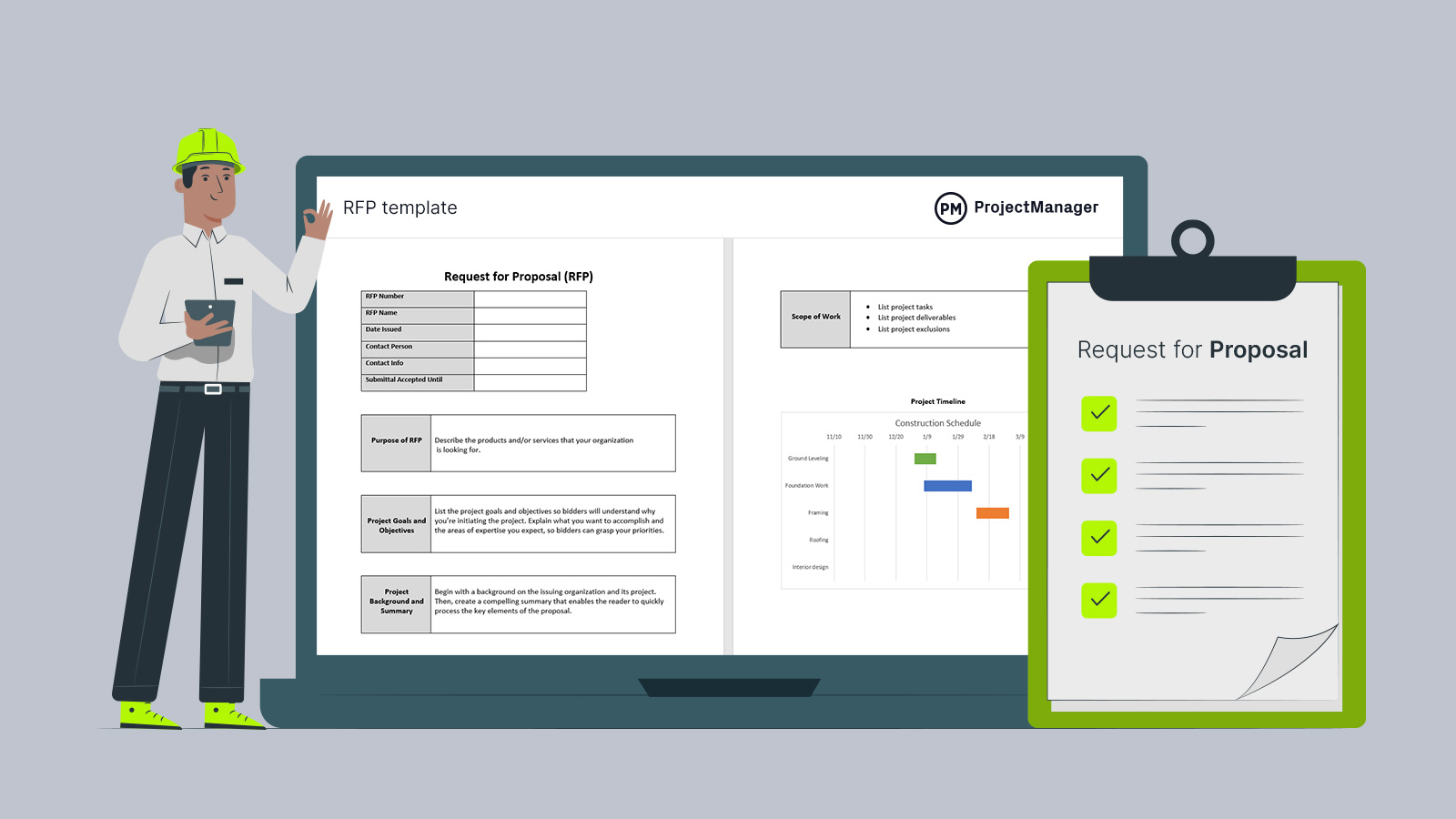
Get your free
RFP Template
Use this free RFP Template for Word to manage your projects better.
RFP in Project Management
RFPs are particularly important in the project management space as they help keep project managers organized and help them make crucial business decisions. Each RFP outlines different vendor options complete with details on pricing, steps in the process, contract terms and more.
It is through these RFPs that project managers can sift through the information to determine the best path forward on behalf of their organization. It is up to the project manager to select the RFP that best aligns with the project and its goals to choose the ideal vendor for the project.
RFP project managers are not only critical thinkers and team leaders but they are detail-oriented, patient and strategic in order to act as an advocate for their organization.
The RFP Process: How to Create an RFP
There are no set rules for creating an RFP, as they can vary from company to company, industry to industry and for-profit and not-for-profit organizations. However, they do share a common goal and usually, the RFP process will hit these pertinent points.
1. Create Project Boundaries
Prior to the pen hitting the paper, speak to the higher-ups in your organization about the constraints for the project, such as what the highest budget they’d approve is, the flexibility of the deadlines, which requirements are a must-have and so forth.
2. Identify Stakeholders
An RFP is a complicated matter that requires a deep knowledge of the project and the organization. Identify key stakeholders and select a representative group that is open to meeting with whomever you assign to oversee the process so they can use them as a soundboard.
3. Interview Stakeholders
Once you have identified the stakeholders, and while you’re in the process of figuring out who can be on call for any questions, also get them to define the project needs. Their answers will inform not only the RFP process but the entire project .
4. Write the RFP
The writing of an RFP can be helped by using an RFP template, which we’ll provide links to below. They are generally structured as follows.
- Organizational background
- Short project description
- Project requirements and objectives
- Project budget
- Milestones and deadlines
- Further info and/or questions
- Contact info and the deadline for submission
5. Create Scoring Criteria
Before you send out the RFP, review it once more, but this time rank the importance of the replies you receive from the vendors and contractors who respond. This is a good method for selecting a smaller group of qualified candidates.
6. Send Out the RFP
Naturally, the whole point of this process is to get it into the hands of prospective vendors and contractors. Therefore, you need to figure out the best place to publish your RFP so that it reaches the right people. It helps to employ consultants to guide you through this phase.
7. Review Responses
After the deadline for submissions, gather all the responses and do a quick read-through to get an idea of the proposed solutions. You can then apply the scoring system you developed earlier.
8. Research
You might get some responses offering a solution that you’re unfamiliar with. It’s important to do the research and see if these might be viable, even if they’re not on your radar. Another part of the research includes doing background work on the vendors and contractors who replied to get a better picture of who you might be contracting into work.
9. Select a Vendor or Contractor
Pick the vendor or contractor who fits your criteria; then do a background check to track their record working in previous projects. This will initiate a negotiation, as a proposal is just that. It may be accepted as-is, or it may require some back and forth. Once everyone is on the same page, sign a contract.
Request for Proposal (RFP) Template
This free RFP template allows you to define what construction contractors will need to include as part of their project proposals when bidding on your project.
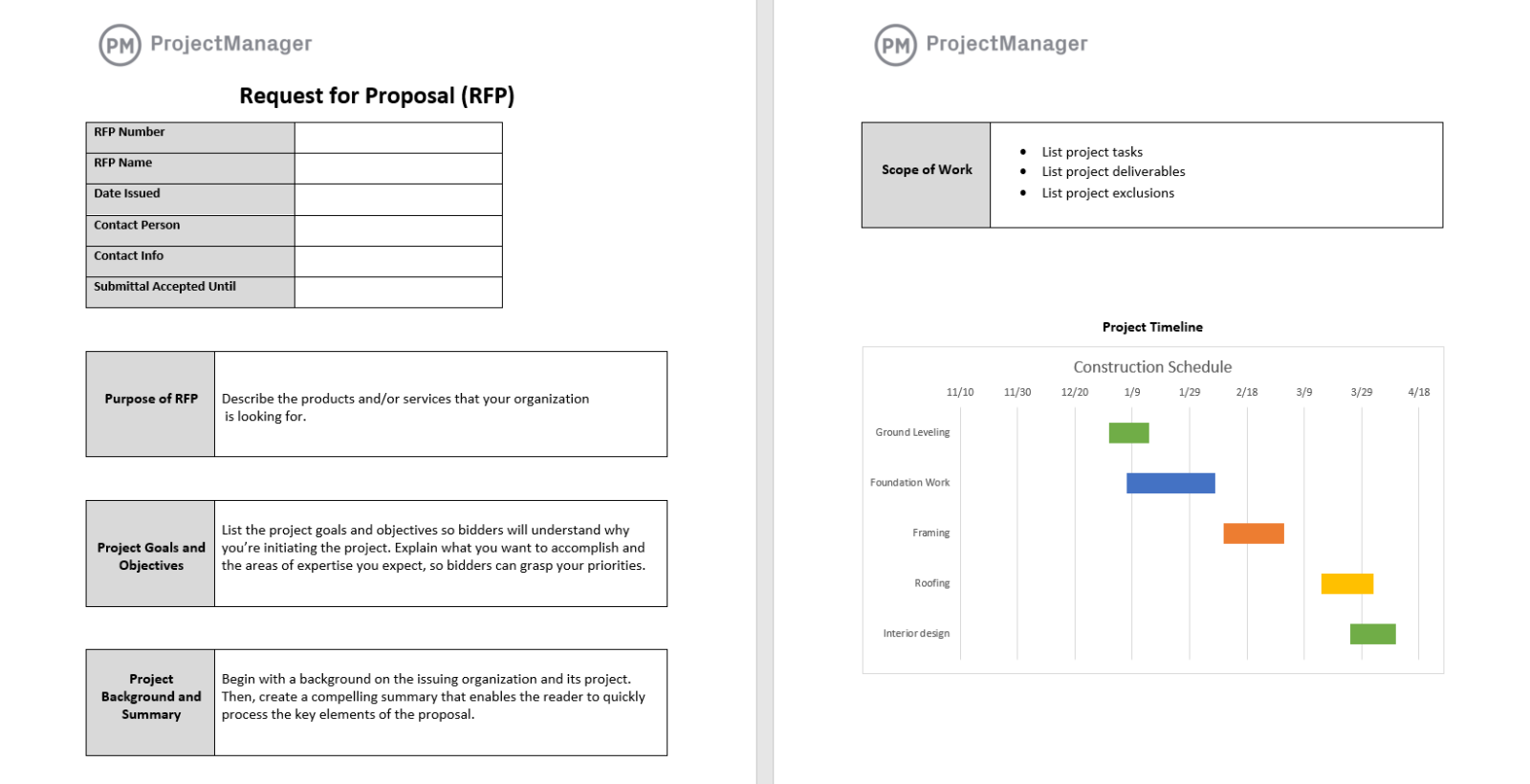
We offer a variety of free construction project management templates for Excel you can use to manage all aspects of your construction project.
RFP Examples
We’ve been general in terms of RFPs, but there are in fact several different types that speak to a specific industry or stage of project development. Here are some RFP examples, but there are many others, and RFPs can vary in style depending on organization and industry.
- Marketing RFP: When a marketing agency is creating its marketing materials, whether that is a case study or a campaign, they will often employ talent through one of these.
- Branding RFP: Creating a brand for an organization requires guidelines, and the organization will have certain expectations, which are outlined in this type of RFP.
- Design RFP: This RFP targets graphic artists to develop print, web, mobile or other advertisements.
- Website RFP: When you’re building a website, you need to employ web developers and other specific talent related to web design, who will reply to this kind of RFP.
- Government RFP: Any work done for a government agency requires an RFP that will outline the specific requirements associated with that office.
- Nonprofit RFP: When working with a nonprofit organization there are different criteria than with a for-profit business, which will be detailed here.
- Finance RFP: RFPs in finance are often formal questionnaires that investors send to financial services firms to help them choose the right financial partner.
- Construction RFP: Organizations can obtain additional details and better understand how to accomplish their goals through RFPs, ultimately helping them choose the best vendor.
- Procurement RFP: RFPs are often one of the first steps in the procurement process and aid businesses in choosing the vendor that meets their list of criteria. RFPs in procurement often follow a request for information (RFI).
- Real Estate RFP: In real estate, agents put together RFPs on behalf of their tenants to outline important points and economic terms for each deal.
More RFP Templates
RFP templates come in all shapes and sizes. The simplest are maybe only a few pages, but they can expand to dozens. There are some that have coversheets and flashy presentations, while others are barebones, just-the-facts documents.
What is right for you depends on the project and your organization or maybe just a personal preference. The following are a few sites that offer RFP templates to download. Visit them and see if there’s one that works for you.
- TemplateLAB
- CRM Landmark
RFP is a Project: Try Using Software to Manage the Process
An RFP, even with an RFP template to guide you, is nothing that can be thrown together quickly. It involves research and a thorough breakdown of the project ahead. In fact, it is a project within a project. It makes sense, then, that project management software like ProjectManager can help you as you build your RFP.
Plan your RFP with our interactive Gantt chart, which schedules all your tasks on a timeline. Set milestones on the timeline to break up your work into more manageable segments, such as the delivery of project description, goals, objectives and budget.

Our kanban boards are a visual tool that shows your workflow and helps you avoid bottlenecks by keeping resources matched with capacity. Take all the steps in the RFP process and make each a kanban card, which has space to describe it, tag it for priority and more.

Once assigned, watch as it moves from column to column indicating where in the process it is. Team members can comment at the task level if they have questions and tag other project members to bring them into the conversation as needed. Collaboration helps everyone work more productively.
Ready to make that RFP a success? Don’t take any chances, use ProjectManager, cloud-based software that helps you work more efficiently. Get the features you need to plan, monitor and report on your work better. Try the tool for free with this 30-day trial.

Deliver your projects on time and on budget
Start planning your projects.
RFIs: The Simple Guide to Writing a Request for Information
Published: March 04, 2022
Large corporations and government agencies don't shop around for the best contractors and freelancers the same way a SaaS company or a small business might.

Rather than relying on word of mouth, a quick Google search, or a Facebook ad, these organizations follow a procurement process that ensures fair business practices and quality results.

As a preliminary step in the procurement process, an RFI gives a company or organization the information it needs to move forward with an RFP and RFQ. But what exactly is an RFI and what does this acronym stand for?
What is an RFI?
An RFI (Request for Information) is a tool used by procurement teams (buyers) to understand the options available for solving a problem or completing a task. Suppliers (sellers) respond to RFIs with information about their products and services.
RFIs are important because they reduce blind spots and empower your team to make better decisions. With more information at your disposal, you can understand the marketplace and get a better sense of the questions you'll need to ask as you move forward in the procurement process.
.png)
Free RFP Templates
Fill out the form to get these templates.
- One-Pager RFP
- Longer In-Depth RFP
- Designed PDF RFP
You're all set!
Click this link to access this resource at any time.
How does an RFI work?
Step 1: the buyer develops the rfi..
RFIs are written documents with the goal of collecting information from sellers. This information can be used to help buyers make a purchasing decision. The questions that are included in an RFI are specific and straightforward so that the sellers understand what the buyer is asking for.
Sellers can find an RFI on the company's website, in databases like Procore , and government web pages like grants.gov .
Step 2: Sellers draft responses to the RFI.
Once a seller finds an RFI, they have a window of time specified by the buyer in which to complete it.
The information that is collected in the RFI is organized in such a way that it can be compared and contrasted against the information that other sellers submit.
Step 3: The buyer reviews all the sellers' responses.
After the deadline for RFIs closes, the buyer reviews all of the responses submitted by the sellers. In this step, the buyer is looking for information about the companies, the products or services they offer, its history and background, and other factors that can impact how well the seller can deliver on the project.
Note: Price, budget, timeline, and other specific information aren't covered in an RFI since it's a part of step one in the overall procurement process.
Step 4: The buyer moves onto the next stage in the procurement process — the RFP.
After the buyer has determined which of the RFI submissions meets the preliminary qualifications for the project, they'll move on to the next step in the process which is an RFP (Request for Proposal).
Both RFIs and RFPs are tools used when procuring new tools, services or vendors. However, a Request for Proposal (RFP) is different from a Request for Information (RFI) in a few ways, including the timing and the type of information required.
An RFI is the initial step a company takes to solicit information from potential sellers , as described above. Its main objective is to obtain information, not to make a final decision. Once the RFIs are submitted, the company will review them and shortlist the best options, armed with more insight. Then, they'll send an RFP to that short list of sellers that satisfied the requirements of the RFI.
A Request for Proposal is a formal request for the selected vendors or sellers to respond to a specific contract opportunity. The document specifies the scope and price so potential sellers can put together a bid for the work.
These bids are then compared to understand each seller 's strengths and weaknesses, and the best fit is chosen. RFPs are a decision document, so the questions are more targeted and specific.
After an RFP, the company may be contacted with an RFQ or Request for Quote that breaks down the project even further into specific cost structures and deliverables.
Request for Information Template
And RFI is similar to an RFP, but with less detail. Download the template below and use the short, one-page version of the request for proposal to draft your RFI. Once you've downloaded your free copy, follow along with the steps below to learn how to write an RFI.
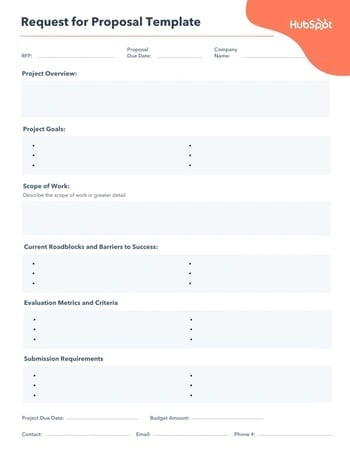
Download Now
How to Write an RFI
Creating your first RFI can be overwhelming. What should you ask for? What information does the seller need to know? To help answer those questions, use this simple guide to get the most out of the RFI process.
1. Draft an overview or statement of need.
Outline your goals and objectives, along with some general information about your company. This section should be short and provide an overview of your project to someone with no background information.
2. Add context about your organization.
Including additional information about your organization can help the seller tailor their response to your needs. You may want to mention which department is leading the project, who your customers are, and what your company values are, among other things.
3. Finalize the details.
What problem are you looking to solve? What information do you need? Here's where you can detail what you're looking for. Include any additional information a seller might need to know to develop a thorough RFI response. That may include:
- Any necessary skills and credentials the respondent may need to be successful
- Timelines or general scope
- What you're not looking for
4. Mention information about the process.
Explain how interested parties should respond to the RFI. Attach a response template if you have one, outline any deadlines, and note if and when you'll reply to respondents after the RFIs have been gathered. You may want to mention any evaluation criteria you'll use when creating the shortlist for RFPs.
Best Practices for RFI Documentation
The more thoughtful you are about your RFI document, the better quality responses you will get back. Instead of casually emailing a sales rep and asking for information, creating RFI documentation will ensure that you get exactly the information you need. In that document, be sure to:
- Clearly state the information you're requesting.
- Be specific about how and when you want to receive seller responses.
- Keep an open mind so that sellers can provide additional information that they think is relevant.
- Be brief and respectful of the sellers' time.
RFI Examples
Need more inspiration? Read through the following examples of RFIs for more ideas on what to include in yours. These three RFIs all come from different industries and have different needs, so they are a good overview of the options available to you.
1. U.S. General Services Administration
In 2021, the U.S. General Services Administration collaborated with the U.S. Department of Energy to issue an RFI supporting a project to reduce commercial building greenhouse gas emissions. The overall goal that the GSA and DOE were aiming to reach was net-zero carbon emissions within these buildings and the RFI focused on three specific areas that would allow this goal to be achieved. Sellers who had technology to meet the requirements of this RFI were required to propose measurable success criteria across several categories.
Image Source
In addition to the RFI requirements on the webpage, the GSA and DOE hosted a webinar, provided an FAQ, and made the presentation slides from the webinar available on the webpage so that all sellers had access to the information they'd need to submit the best response.
What makes this RFI example stand out is that it's kept up to date frequently. New information is added frequently. When the deadline is passed, that is notated clearly at the top of the RFI so sellers can move on to other requests that are accepting submissions. This is a great example of the best practice we mentioned earlier about respecting the sellers' time when asking for RFI submissions.
When NASA retires parts of their space shuttles, they like to display them at museums or other educational institutions. To gauge interest and understand the potential options for an upcoming retired part, they opened up an RFI . Here's a sample of the document:
"This RFI is being used to gather market research for NASA to make decisions regarding development of strategies for placement of Space Shuttle Orbiters and Space Shuttle Main Engines (SSMEs) for public display after conclusion of the SSP. NASA is seeking information from educational institutions, science museums, and other appropriate organizations about the community's ability to acquire and display a Space Shuttle Orbiter after the vehicles are retired from flight status."
We like this RFI example because it provides a straightforward overview of the purpose of the RFI, and outlines what NASA wants to learn from the process.
3. Government of Canada
Government websites are a great place to find RFI examples because they are required to make all procurement processes publicly available. The following example is from an RFI for financial planning software.
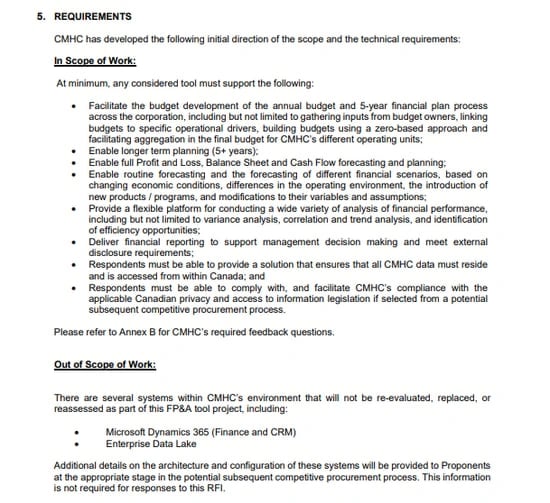
The requirements section of this RFI is a great example of how to explain what you do and don't need in the responses. While the government of Canada is looking for financial planning software, they will be keeping their CRM and data lake provider.
4. University of Ottawa
In the following RFI except, the University of Ottawa is looking for an ERP integration solution. What's unique about this RFI is how they want to receive responses. Rather than collecting written responses or documents, the U of O is scheduling strategy discussions with suppliers. This is a unique way to gather information, but helpful when you don't have enough knowledge in the area to put together a scope of work yet.
"The University of Ottawa (University) is issuing this Request for Information (RFI) to schedule strategy discussions (via a conference call) from interested Suppliers with experience in ERP Integrations.
The intent of these discussions is to obtain feedback from Suppliers to assist the University in developing a more accurate Scope of Work and overall approach for an upcoming Request For Proposal (RFP) for ERP Integration solutions."
Request for Success
Every RFI will be unique to your organization and the information you require. Use the template above as a guide to creating an RFI that will save you time in evaluating potential solutions.
With the right information being sent your way, all you need to do is read up! You'll be well on your way to procuring the best solution for your team's needs.
Editor's note: This post was originally published in April 2021 and has been updated for comprehensiveness.
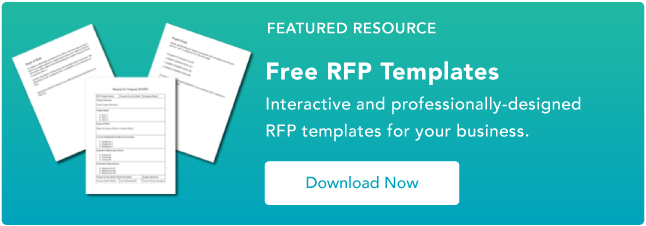
Don't forget to share this post!
Related articles.

How to Write an RFP for Grants – Everything You Need to Know

Can Automation Help You Ace Your RFP? I Used AI to Find Out
![market research request for proposal template RFP: How to Write a Strong Request for Proposal [Example & Template]](https://blog.hubspot.com/hubfs/rfp_featured.png)
RFP: How to Write a Strong Request for Proposal [Example & Template]

The Ultimate Guide to RFPs

RFQ vs. RFP: What’s the Difference?

How to Win More Proposals by Interviewing Your Prospects

Why You Should Never Email a Proposal
The Right Way to Think About Your Marketing Software RFP [+Sample]
Free, Unique RFP Templates to Start Using Immediately.
Marketing software that helps you drive revenue, save time and resources, and measure and optimize your investments — all on one easy-to-use platform

IMAGES
VIDEO
COMMENTS
If the budget is tight, the market research company should be willing to be flexible to offer options for 200, 300, and 400 responses. 💡 The Key Takeaway: The main elements to consider when receiving your RFP responses are the following: responsiveness, interest, experience, and cost.
A market research proposal is a document that sells your services to potential clients by showing them what they can accomplish by hiring you to complete their project or research study. It includes a summary, objectives, existing knowledge, intended outcomes, target demographics, data collection methods, a detailed research methodology, a ...
There are 11 steps to create a sound and compelling market research proposal. 1. Market Research Proposal Summary. Start your proposal by briefly explaining the purpose of the market research and why it is required. Also, give an overview of what the desired outcome of the market research is.
Definition of terms. List the terms that will be used in the market research proposal. Make sure to define them properly. Market conditions. Give an overall picture of the current market conditions. Explain the industry's state and the competition level, as well as mention relevant economic or even political factors.
Writing a market research request for proposal (RFP) can seem like an daunting real overwhelming mission. The RFP process involves a lot of point, spirit, real information gathering. This of course is all that work which comes before you've even started the massive task of reviewing the entries or choose one vendor.
Use this section of the marketing research proposal to thoroughly describe all data collection methods which will be utilized in your research. The overall strategy can be addressed, as well as the individual data collection methods. For market research, these often include methods such as focus groups, surveys, social networking research, or ...
Market Research Playbook. This tool can be used alone, but it's also part of the comprehensive Market Research Playbook. It provides step-by-step planning guidance while also helping you utilize more than 25 downloadable tools from the popular AMA Marketer's Toolkit library. View PLAYBOOK. This tool is powered by Demand Metric. Join AMA.
Start sending high conversion proposals today. Join 10,000+ happy customers and enjoy a simpler, faster, and more professional way to win more business. Try it Free. This free market research proposal template is written for anyone that offers market research services. Use it to save time writing better proposals.
Companies that conduct market research and analysis can use our sample marketing research proposal template as an example of how to write a market research proposal, and as a guide when preparing survey proposals, data collection proposals, or business research. This template allows you to explain your methodology for gaining qualitative and ...
The market research RFP template by Drive Research can helpful as an initial structure for some organization watch to get started with marketing exploring or who who know exactly what they want. This request for proposal sample can and should be tailored to best articulate your organization's needs from who research.
Here are three tips from my arsenal to help you optimize your RFPs to achieve a high response rate from vendors. 1. Keep the lines of communication open. Providing access to a point of contact shows that your company is invested in the vendor response process and helps you proactively establish a rapport.
The quality of your RFP has a direct impact on the quality of your project's outcome - for better or for worse. Complete the form to download our guide on How to Write a Great RFP. Inside you'll find: A detailed checklist of what to include in your RFP. Example RFP template to help guide you.
A well-structured research proposal includes a title page, abstract and table of contents, introduction, literature review, research design and methodology, contribution to knowledge, research schedule, timeline and budget. Visme's research proposal examples and templates offer a great starting point for creating engaging and well-structured ...
A market research proposal will outline your market research plan and each critical step you need to take to perform the necessary research. It usually consists of three parts. Introduction: This includes project objectives and scope, target market, and methodology, including data collection methods. Discussion: This covers existing knowledge ...
Research proposal examples. Writing a research proposal can be quite challenging, but a good starting point could be to look at some examples. We've included a few for you below. Example research proposal #1: "A Conceptual Framework for Scheduling Constraint Management".
Download. State the objectives, scope of work, research methodology, target market, and other such important information of your market research by downloading and using this above-shown research proposal example template. This ready-made template's content can be edited and customized in various file formats such as MS Word, Pages, Gooogle ...
We created the Market Research RFP Template to help you generate a request for proposal (RFP) for market research support services. Sections include: Company Information, Statement of Work, Proposal Submission Procedure, Scope of Work & Business Requirements, Vendor Information, and Estimated Budget & Resources Required. The purpose of this RFP ...
An RFP, on the other hand, is used when a business has clearly defined project needs and is ready to solicit detailed proposals from qualified vendors. RFPs dive deeper into specifics like scope, deliverables, timeline, and budget. In short, an RFI is for exploration, while an RFP is for vendor evaluation and selection.
The current status of your marketing campaign. Your point of contact. Your statement of purpose can be short and sweet — just to let an agency know why you need a proposal. 2. Company information. For a marketing agency to properly quote you, it's important to provide as much company information as possible.
Research. You might get some responses offering a solution that you're unfamiliar with. It's important to do the research and see if these might be viable, even if they're not on your radar. ... Request for Proposal (RFP) Template. ... Marketing RFP: When a marketing agency is creating its marketing materials, whether that is a case study ...
An RFI (Request for Information) is a tool used by procurement teams (buyers) to understand the options available for solving a problem or completing a task. Suppliers (sellers) respond to RFIs with information about their products and services. RFIs are important because they reduce blind spots and empower your team to make better decisions.
Identify key team members for your RFP and set up project management structures 6 Module 2: Information Gathering to Inform Your RFP Conduct market research, engage key stakeholders and service recipients, and learn from prior service delivery 15 Module 3: RFP Writing -Problem Statements and Goals